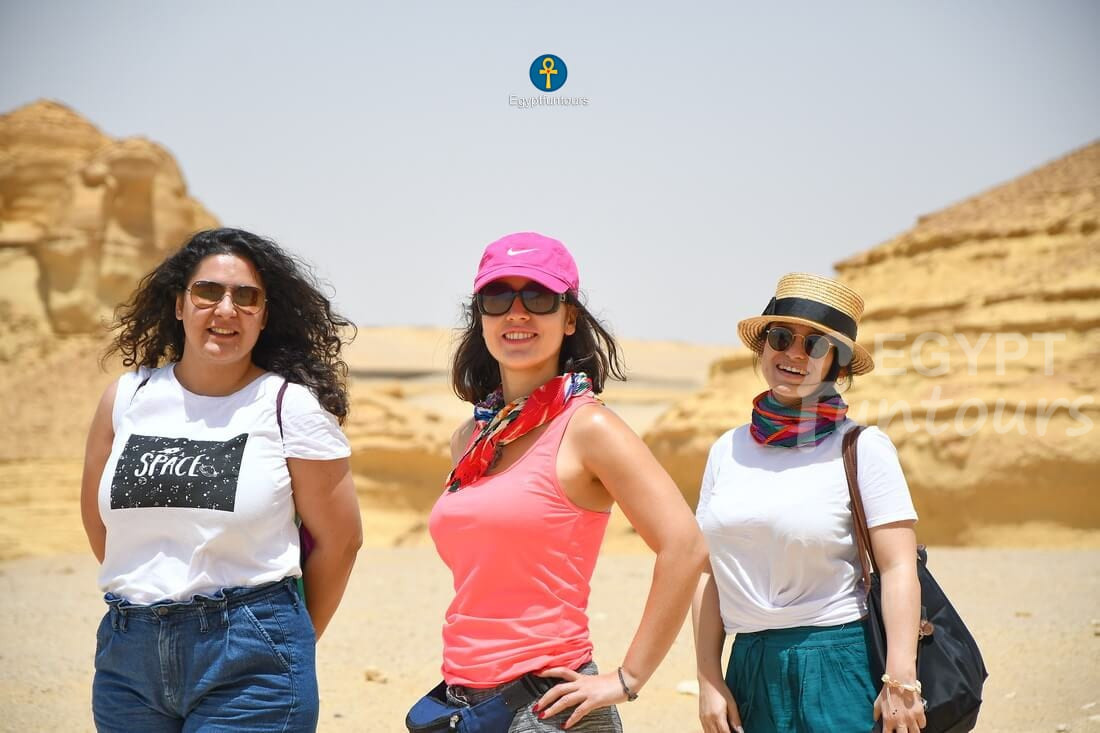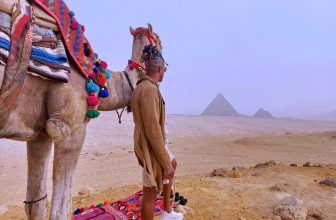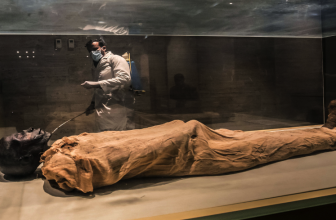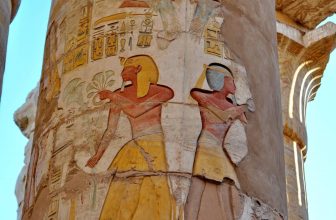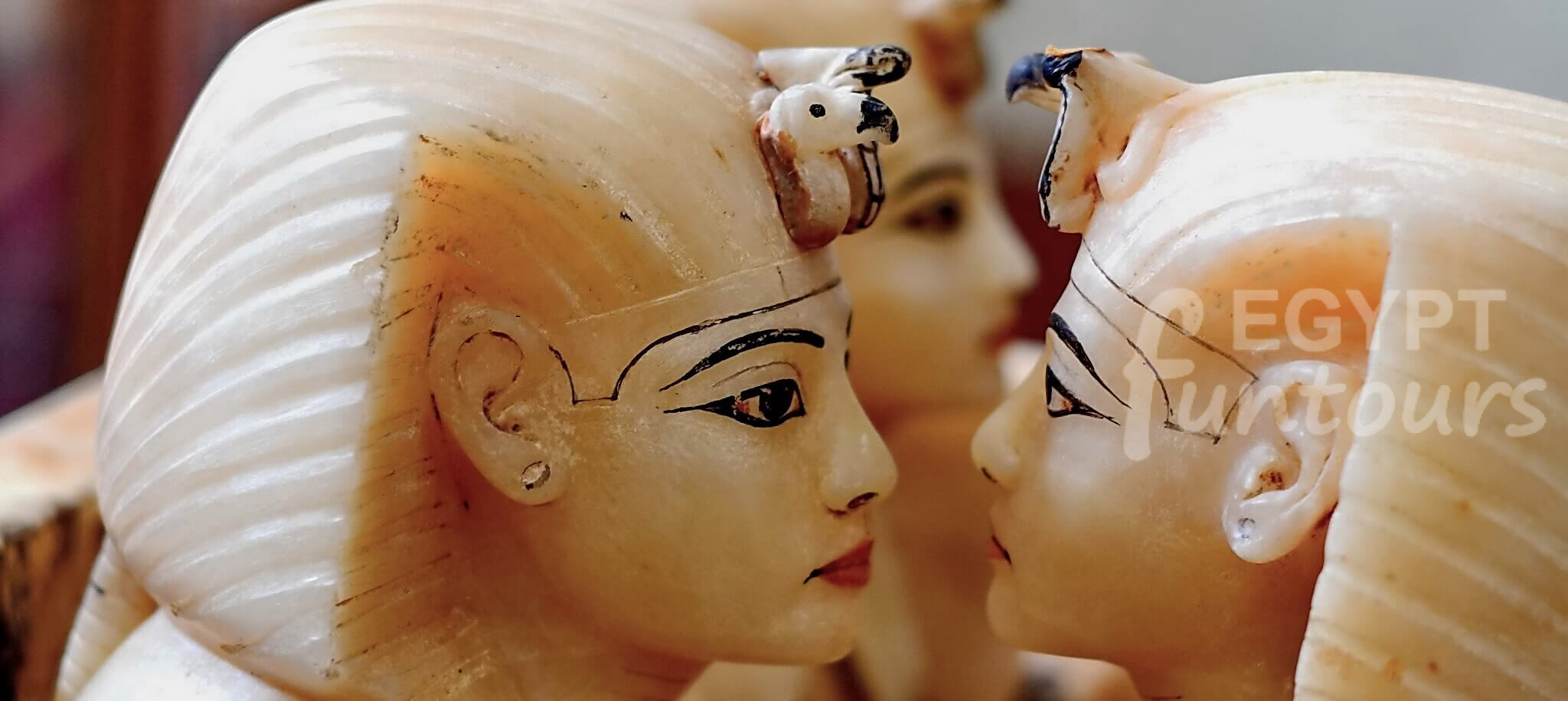Read all that you need to know about Egypt Tourist attractions on this Egypt in Pieces web page! We at Egypt Fun Tours think a lot about how to help you plan your perfect trip, we found it useful to list all the Egyptian places that can be visited by tourists with some information about each place in a very easy clear language to provide you with the background needed for your travel in such an old country.
Cairo (Al-Qahira)
Cairo, the undefeated almighty was founded at the end of the ninth century by the Fatimid’s Muslim rulers, the leader was named Gawhar Es’seqeli, while the Khalifa of all Islamic Empire was Al-Muez Ledinellah Alfatimi. Al-Qahira’s ancient downtown took the place of Khan El-Khalili bazaar used to be the ancient Souq and the business center of the City.
The fortified city was surrounded by a huge enclosure wall accessed by three gates named Bab El-Fottoh, Bab El-Naser, and Bab Zuaila, each was founded for a specific function; Bab El-Fottoh from which the Muslim army left for battles, Bab El-Naser was used to welcome the victorious army back to the city, while Bab Zuaila was special for hanging the dead enemies or their heads for everybody to see the strength of the Muslim army.
Nowadays the Term Cairo refers to the Capital city of Egypt (214 square kilometers-83 sq mi), the largest city in Africa and the Mediterranean countries with a population of over 16.8 million.
Places to see in Cairo:
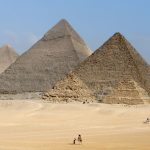
Giza Pyramids
The most well-known tourist site in the entire globe is the Giza Pyramids. The great pyramid was the highest building in the world for a very long time. Nine pyramids from the fourth dynasty may be seen on the plateau; they were all built for royal funerals and to be the monarchs’ ultimate resting places. The Great Pyramid of Giza is the only one of the ancient seven wonders of the world that is still intact, making it stand out among the other 118 Egyptian pyramids. King Khufu, the second ruler of the fourth dynasty, is buried there. The Pyramid of King Mycarinus is the smallest of the three Giza Pyramids, whereas the Pyramid of King Khafra, his son, is the second-largest pyramid in the entire globe. The wives and sisters of the Kings are honoured by the other six pyramids at Giza. To the east of the large pyramid are three smaller pyramids that belonged to Queen Henutsen, Khufu’s wife; Hetephereth, his daughter; and a third little pyramid that belonged to an unidentified Royal female. The six miniature pyramids’ last three structures belonged to King Mykarinus’ wives. Great Pyramid of King Khufu Facts The largest pyramid ever built is

The Pharaonic Village
Imagine going to a place a few miles from the center of Cairo where Egypt’s history and art come alive! At the Pharaonic Village, you’ll see faithful reproductions of buildings, clothing, and lifestyles, a complete replica of the tomb of Tutankhamen, and museums relating to different periods of Egyptian history. Dr. Hassan Ragab created this living museum from the beginnings of a papyrus plantation on Jacob Island. With a vision, he was able to recreate ancient life with unrivaled collections of endangered plants and species. Carrying on the tradition is Dr. Ragab’s son, Dr. Abdelsalam, who continues to improve and add to the village. Because of their meticulous attention to detail, the unique exhibits offer more than education and entertainment, they are a vital resource for the preservation of our knowledge of the Ancient world and modern history. Join us and embark on an adventure into the rich and exciting times of the Pharaohs and beyond. The official site of the Pharaonic village Dr. Ragab’s Pharaonic Village As a summary of your trip, and also great fun for the kids, you should drag the Pharaonic village into your list of fun places to see in Egypt. It is a big
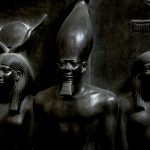
Egyptian Antiquities Museum in Tahrir Square
The Egyptian Museum of Antiquities, located in Cairo, Egypt, is a world-renowned institution that houses the largest collection of Egyptian antiquities in the world. Established in 1901, the museum is an impressive building that exhibits over 120,000 artifacts that represent the various historical periods of ancient Egypt. The museum features numerous galleries that provide visitors with a glimpse into ancient Egyptian life and culture. The ground floor hosts an impressive collection of statues, sarcophagi, and papyri, while the first floor is home to the Royal Mummies Room, where mummies of ancient Egyptian Pharaohs are displayed. The museum’s collection includes a wide range of artifacts, from everyday household items to priceless treasures that belonged to influential figures in ancient Egyptian history. One of the museum’s most famous exhibits is Tutankhamun’s treasure, which includes his iconic gold burial mask. Other notable exhibits include the Narmer Palette, the Akhenaten Gallery, and the Egyptian Jewelry Gallery (most of which are moved to the New Grand Egyptian Museum). The museum is also home to fascinating papyri dating back to the Old Kingdom, as well as the fascinating tomb artifacts of the Valley of the Kings. Aside from the museum’s collection, the Department of Antiquities operated

Salah Ad-din Citadel in Cairo
Saladin Citadel in Cairo was founded by Salah Ad-din in 1168, and it was completed by his nephew King Al-Aadel. It is located on a high hill named Moqqattam overlooks the old city of Cairo from the eastern side. Salah Ad-din was the ruler over Egypt for 24 years, he is very well known for his victory against the Crusaders who were defeated in the battle of Hattin. The citadel is a large fortified area, the enclosure wall supported with huge rounded and square archers’ towers. Salah Ad-Din Citadel in Cairo: Exploring an Iconic Monument of Egypt The Salah Ad-Din Citadel in Cairo, Egypt, is one of the most remarkable historical monuments in the country, steeped in profound cultural and historical significance. This impressive fortress, also known as the Cairo Citadel, is perched on a hilltop and overlooks the city of Cairo. With its long and storied history, Salah Ad-Din Citadel is a must-visit site for anyone interested in Egyptian history and architecture. History of Salah Ad-Din Citadel Commissioned by the Muslim warrior, Salah Ad-din al-Ayyubi, during the time of the Ayyubid dynasty in 1176, Salah Ad-Din Citadel was built to protect the city of Cairo from Crusaders. Thus, serving
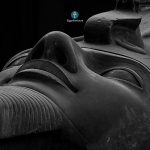
Memphis
King Nar-Mer, the founder of the first dynasty and the unifier of Egypt’s two regions, Upper Egypt and Lower Egypt, built Egypt’s very early capital city. The city was called from the name of King Pipi’s pyramid, Mn-Nefer, which means “beautiful and stable,” and was subsequently dubbed “Memphis” by the Greeks who visited Egypt. The Memphis artifacts are currently housed in a small open-air museum in the current Meet-Rahina village. The city formerly had several temples, the largest of which was the temple of Ptah, the northern capital’s principal god. Visitors may now only see the remains of Memphis at a museum that contains the colossus Ramses II, the new kingdom Alabaster sphinx, and a few other artifacts. Memphis’ Open Air Museum is one of Egypt’s “must visit” attractions! The journey from Cairo takes 45 minutes, the museum is only 20 kilometers south, and the admission cost is extremely low. Throughout the Old Kingdom, Memphis was the capital of Ancient Egypt. Many Egyptologists think that Memphis was once a very large city because of the enormous number of necropolises (old cemeteries) connected with it, despite the fact that there is no archaeological evidence to support this claim, even now.

Giza Zoo
Because it is more than 130 years old, one of the largest in the world, measuring 120 acres and including numerous old trees and animals. The Giza zoo was created by khedive Abbas II Hilmi Bey (also known as Abbas Hilmi Pasha), but his father, Khedive Muhammed Tewfik Pasha, came up with the concept. The Giza zoo is still the most popular tourist attraction among Egyptians, with hundreds of school children visiting every day from outside the city, and schools in Cairo organizing weekly visits to the zoo. Animals, birds, and reptiles of all types are popular among visitors. The Zoo is regarded as a huge display of African wildlife. It is home to a variety of animals and birds that have been extinct in Egypt. They will be returned to their natural habitats, from which they became extinct. Mountain goats and rams, Egyptian gazelles, and herons are among them. The zoo is divided into five mountainous sections, the largest of which is Citadel Hill, which was built in 1867. It is adorned with statues of the Fayoum rhinoceros, crocodiles, and odd birds, all of which are extinct. Its plateau is encircled by a small park that may be accessed

Khan El-Khalili Bazaar
Khan el-Khalili is a historic bazaar and souq located in the heart of Cairo, Egypt that was established as a center of trade during the Mamluk era. The district is named after one of its caravanserais and has become a popular attraction for tourists and locals alike. In the 10th-12th centuries, the area was part of the Fatimid Caliphate and later developed into an economic center under Salah ad-Din. The bazaar was founded in the 14th century and underwent several modifications and redevelopments over the centuries, including by Sultan al-Ghuri in the early 16th century. In addition to shops, the bazaar is now home to coffeehouses, restaurants, and street food vendors. It has also been the subject of literary works such as Naguib Mahfouz’s “Midaq Alley” and was unfortunately targeted in a terrorist attack in 2005. Tourists can buy a wide variety of souvenirs at this market, however, most of what is sold currently are made in China, with the exception of some women’s accessories, gold, silver, and herbs. Seket El-Badestan is the bazaar’s major street, which runs from the western corner of Al-Hussein mosque to the main street of Al-Muizz. Another important route that is part of the bazaar

Amr Ibn El-Aas Mosque
The very first mosque ever built in Egypt. Erected in 642 AD (21 AH) by the leader Amr Ibn alas, the commander of the Muslim army in Egypt, the mosque is also known as Taj al-Jawamie (Crown of Mosques, al-Jamie’al-Ateeq (the Ancient Mosque) and Masjid Ahl ar-Rayah (Mosque of Banner Holders). The mosque is said to have been built on the site of Amr Ibn el-As’ tent at Fustat, which is the oldest existing mosque, not just in Cairo, but the entire African Continent. Located north of the Roman Fortress of Babylon, it is actually on the edge of Fustat, the temporary city founded by Amr, and was an Islamic learning center long before El-Azhar Mosque. It could hold up to 5,000 students. The mosque was originally built on an area of 1,500 square cubits, overlooking the Nile. The initial structure was quite simple; with walls bare of any plaster or decorations, but without niche (mihrab), minaret or ground cover. It had two doors on the north and two others facing Amr’s house. The mosque area remained unchanged until 672 AD (53 AH), when Musallama al-Ansari, Egypt’s ruler on behalf of Caliph Mu’awiya Ibn Abi-Sufian undertook expansion and renovation works

Church of Saint Sergius (Abu Serga)
The church of Saint Sergius is situated to the north of the Coptic Museum, down a narrow cobbled lane, and lies some three meters below street level. The church is dedicated to two Roman officers, Sergius and Bacchus, who were martyred in Syria in 303. The earliest part of the building dates from the fifth century and was built over the cave where, according to tradition, the Holy Family hid during their Flight into Egypt. The structure was burnt down and restored in the eighth century. The whole of the church was again restored and partially rebuilt during the Fatimid era (tenth to twelfth centuries). Despite restoration and reconstruction, the church of Saint Sergius is nevertheless regarded as a model of the early churches in which Copts worshiped. The entrance is approached down a flight of stairs. It leads to the side of the narthex, where there is a large plunge-bath, boarded over. At the end of the narthex is the baptistery. The nave of the church, which has an arched timber roof, is separated from the side aisles by marble pillars. The figures that once decorated the columns are only dimly discernible today. On the right -hand wall is

Saqqara Pyramids (Djoser’s Complex)
Saqqara (Sakkara) is the largest ancient site in Egypt, was one of the cemeteries of Memphis together with Dahshur, Abu Rawash, Abu Sir, and Giza. It accommodates the step pyramid of King Djoser with his complex, some other pyramids from the 5th and the 6th dynasties, and many Mastabas from the old kingdom. Visitors nowadays can see the museum of Imhotep ( the architect who built the step pyramid of King Djoser). 1. The step pyramid of king Djoser Was built almost 4600 Years ago of limestone to be the northern tomb of king Djoser the founder of the 3rd dynasty. The king gave his orders to his genius architect Imhotep to start the construction work in the northern cemetery, Imhotep had the idea of making a Mastaba for his beloved king (A Mastaba is the familiar design of a king’s tomb of mud-breaks in the old kingdom of Egypt which is designed as one square floor built entirely over the ground to remark its place divided into many chambers centered by the burial chamber of the king surrounded by many funeral chambers for his funeral objects). The pyramid was built first in the form of a Mastaba while, it

Sites of Islamic Medieval Cairo
There are 651 buildings from Medieval Cairo listed in the index produced by the Survey of Egypt in 1951 including mosques, Madrasas, mausoleums, Khanqahs, Khans, Wikalas, and private homes. Today it is estimated that some 450 still remain and it is probable that Cairo has more medieval buildings than just about any other city in the world. For those wishing to enjoy the riches of medieval Cairo, it is best to divide that area into manageable segments. Most of the sites can only be seen in walking tours as most of them fall in small tiny streets that are not accessible by tourist vans. The area is so vast that you can not see in one single day, and it is advisable to divide it into zones to get to see all of it, and also to be able to choose which to see and which to skip. Available tour routes covering Islamic Cairo sites: From the Saladin’s Citadel (Bab El-wazir street) to Bab Zuwaila. From Bab Zuwaila to Al-Azhar mosque (Al-Muizz street) From Khan El-Khalili to Bab El-Foutouh & Bab El-Nasr (Al-Muizz street)
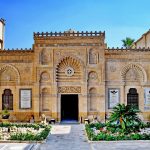
Old Cairo
Old Cairo, Masr al Qadima, lies within the old Roman fortress of Babylon, which was not only a walled but a heavily fortified city, with a narrow streets and cobbled alleys. How the name of the famous Babylon came to be echoed in Egypt is not unknown. The Coptic historian John, who lived at the time of Arab invasion, claimed that it is originally built during the Persian occupation of Egypt (525-332 B.C) and that it was at that time called the fortress of Babylon. However, a much earlier visitor to the land of the Nile, the classical writer Diodorus, asserted that the name was brought y prisoners of war from great Babylon; the twelfth –dynasty pharaoh Senusert III, some two thousand years B.C, brought them to build public works. These Babylonians revolted against the Egyptians and built a fortification for protection, which had long fallen to ruin when the Persians came and repaired it. When the Roman geographer Strabo came to Egypt in 24 B.C., he that Old Cairo was a fortress town and was occupied by three Roman garrisons. The emperor Trajan(98-117) cleared a canal that was running through the city and included some urban areas into the

The National Museum of Egyptian Civilization (NMEC)
National Museum of Egyptian Civilization The National Museum of Egyptian Civilization (NMEC) is located in Al-Fustat, Egypt’s first capital after the Arab Islamic conquest in 641 A.D, and it was a natural choice for the museum because the area is rich in Coptic churches and monasteries, as well as the Coptic Museum, the Ibn Ezra Synagogue, and Egypt’s first mosque, the Amr Ibn Al-Aas Mosque. The Saladin Citadel can also be seen from the museum’s outdoor spaces, which highlights the museum’s unique location overlooking Lake Ain El-Sira, Cairo’s last natural lake. The museum, which opened in stages in 2017, will house a collection of 50.000 items depicting Egyptian civilization from prehistoric times to the present. The permanent collection is split into two areas, one chronological and the other thematic. Archaic, pharaonic, Greco-roman, Coptic, Medieval, Islamic, modern, and contemporary will be the chronological areas. The following will be the thematic areas: The Nile, writing, state and society, material culture, beliefs and thinking, and a museum of royal mummies are all featured in this exhibition. In a Royal parade in 2021, the royal mummies were transported to the museum. Artifacts on display (Oct 2021) Prehistoric Period Artifacts in Civilization Museum (NMEC) 1
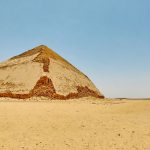
Dahshur Pyramids
Pharaoh Sneferu (Snofru or Snefru) (r. 2613-2589 BCE) constructed three big pyramids and maybe two smaller ones. The cut and prepared stone of his Pyramids total about 5 million cubic yards (almost 3 1/2 million cubic meters). Pharaoh Sneferu’s main construction projects were at Meidum (20 miles / 30 km south of modern Cairo) and Dahshur (12 miles / 20 km south of Cairo). The Pyramid at Meidum Sneferu’s first effort at Pyramid construction was Meidum. Some historians think that this unique building began as a step Pyramid and was subsequently transformed into a genuine Pyramid with flat triangular sides by the addition of more material. The whole outer shell has collapsed, maybe while it was still being erected, making it difficult to determine the original form. What’s left is a massive, 210-foot-tall (65-meter) steep-sided cube with two-tiered stairs at the top, surrounded by deep debris mounds. Two more steps appear to have existed in the 15th century but have subsequently fallen. Although it is possible that this structure was desecrated for ceremonial purposes, conventional archaeology believes that the collapse was caused by poor architecture and that the Pyramid at Meidum marks a step backward in Pyramid construction. Sneferu’s Pyramids
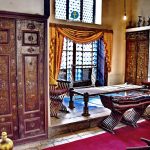
Gayer Anderson Museum (Beyt El Kritliyya)
Bayt al-kritliyya is one of the most beautiful and intriguing examples of 17th-century Arab residential architecture still standing in Cairo, and it provides a perfect environment for ancient Egyptian, Coptic, and Islamic furniture, rugs, and artifacts. It’s off of ‘Abd al-Magid al-Labban (Al-Salbiyya) Street in Sayyida Zeinab, Cairo, on the southeast corner of the Mosque of Ibn Tulun. The History of the House: The museum is made up of two homes that are supported by the Ibn Tulun Mosque’s exterior wall. Hajj Mohammad Ibn al-Hajj Salem Ibn Galman al-Gazzar constructed the bigger home to the east (the farthest side in respect to the mosque) in 1632 (1041 AH). It was eventually acquired by a rich Muslim woman from Crete, and the house became known as Beit al-Kritliyya, or “House of the Cretan Woman.” Abdel-Qader al-Haddad erected the second home to the west (the innermost side in respect to the mosque) in 1540 (947 AH). It was then dubbed “Beit Amna bint Salim” after its previous owner. The two homes were connected by a bridge at an unknown place on the third-floor level, and they are today known as Beit al-Kritliyya. It was usual practice to build private residences against the
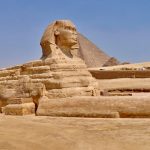
The Great Sphinx
A lion with a human head lies on the eastern side of the Giza plateau, with the pyramids in the backdrop, and is one of the world’s biggest sculptures. The planet’s oldest Sphinx was built by King Kephren; it is a single block of limestone that was previously attached to the main bedrock and is 20.5 meters tall, 73 meters long, and 6 meters wide. The Sphinx Story: When the pyramid of King Kephren was being built, limestone was taken from the area that today houses the Sphinx, and a large portion of the rock was ignored by the workers after being examined and shown to be of poor quality to be cut for the pyramid. After finishing construction work on the pyramid, this piece of rock was still blocking the view of the pyramid, which clearly irritated the king, who most likely gave orders to remove this rock so that the view of the pyramid would be unobstructed. The idea was then hatched to make a statue for the king instead, but the size and shape were inconvenient for making a typical royal statue sitting on a throne. The choice was made then to construct this Sphinx with the
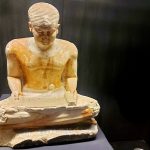
Imhotep Museum at Saqqara.
Who is Imhotep? Imhotep was a brilliant architect who also made significant contributions to art and many disciplines of medicine, making him one of the most well-known architects in ancient Egyptian and global history. Imhotep was the earliest known doctor in human history, and he created several medicines and remedies that were used to treat a wide range of illnesses. He was also the first architect to utilize stone columns in his numerous projects in ancient Egypt, according to historical records. The Imhotep Museum was built at Saqqara to honor the memory of Imhotep, one of ancient Egypt’s most accomplished architects who is credited with the concept of building the pyramid-shaped tombs of the kings and queens that we see today. Imhotep built the Step Pyramid of Djoser, Egypt’s first pyramid, as well as a complex surrounding it. Djoser’s Step-Pyramid is the world’s oldest surviving stone structure. Prior to this, the deceased were buried deep within the ground in mud-brick tombs. With Imhotep’s innovations and creations, all of these ideas altered. Imhotep was the first to employ columns in the construction of diverse structures, to create temple ceilings with stone blocks, and to erect a statue above ground level, in
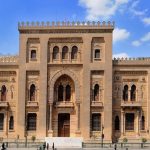
Museum of Islamic Art
The Museum of Islamic Art in Cairo: Exploring the Treasures of Islamic Civilization Cairo, the bustling capital of Egypt, is renowned for its historical and cultural significance. Amidst its rich tapestry of architectural marvels and ancient relics, the Museum of Islamic Art stands as a testament to the artistic and cultural heritage of the Islamic world. This magnificent institution is an oasis of Islamic art, offering visitors a captivating journey through time and a deeper understanding of the profound impact of Islam on art and civilization. A Haven of Islamic Art Nestled in the heart of Cairo, the Museum of Islamic Art is located in the historic neighborhood of Bab El-Khalq. Established in 1903, the museum boasts a vast collection of more than 100,000 artifacts that span over a millennium of Islamic history. It is considered one of the most comprehensive repositories of Islamic art and artifacts in the world. A Treasure Trove of Islamic Artistic Traditions The museum’s collection encompasses a wide range of mediums, including ceramics, textiles, metalwork, glassware, calligraphy, and woodwork. While predominantly focused on objects dating from the 7th to the 19th century, it also includes contemporary pieces that exhibit the enduring legacy of Islamic artistic

Al-Muizz Li-Din Allah Fatimid Street
If you’re looking for a vibrant street in ancient Al-Qahira, Al-Muizz Li-Din Allah Fatimid Street is the place to be! This street is jam-packed with lively spots, as well as stunning ancient mosques and buildings that are sure to take your breath away. It’s no wonder that this street is one of the most popular destinations for tourists and locals alike. History of Al-Muizz Li-Din Allah Fatimid Street High taxation and bad governance by the Ikhshidid Abbasids, who had governed Egypt from 905 AD, devastated the area and its capital, Fustat when the Fatimids gained control in 969 AD. The Fatimids quickly went about consolidating their control over Egypt and its people. The new caliph, Al-Muizz, launched a massive construction project, rebuilding roads, reconstructing the canal system that supported agriculture in the Nile Valley, and creating a new capital, Al-Qahira. The Fatimids were Shi’a Muslims who wanted to spread their version of Islam over the borders of the Sunni Abbasid Caliphate, and they built Al-Qahira to rival the prestige of the Abbasid capital, Baghdad, establishing the groundwork for modern Cairo. Al-Muizz Li-Din Allah Street, named after Egypt’s first Fatimid Caliph, was created as the major street through the Fatimid metropolis,

The Grand Egyptian Museum
The Grand Egyptian Museum (GEM), also known as the Giza Museum, is a proposed museum of ancient Egyptian antiquities. Its purpose is to guarantee that these riches are preserved for future generations. The museum is under construction and is scheduled to be partially open in 2021 and 2022, exhibiting the full Tutankhamun collection with various pieces being displayed for the first time. It is described as the largest archaeological museum in the world, capable of hosting 5 million visitors per year. The museum’s cost is $795 million, which is primarily supported by two loans from the Japanese government totaling $300 million. Egypt’s Grand Egyptian Museum Overview The design of the structure, like that of the Great Library of Alexandria, was selected through an architectural competition. The organizers launched the competition on January 7, 2002, and it got 1557 submissions from 82 nations, making it the second-largest architectural competition in history. During the second stage of the competition, only 20 entrants were requested to submit more details about their concept. The judging was finished on June 2, 2003. The firm Heneghan Peng from Dublin, Ireland won the competition, receiving $250,000 and the opportunity to see their concept come to reality, which

Souq Al-Khayamiya “Tentmakers’ Market”
After seeing the most intriguing ancient landmarks and sightseeing, one of the most fun activities you can do in Egypt is going on a shopping excursion. In Egypt, there are dozens of unique bazaars, open-air marketplaces, and stores in various locations, and one of the most fascinating is the spectacular Souq Al-Khayamiya “Tentmakers Bazaar.” Souq Al-Khayamiya is located beyond the Fatimid Cairo’s southern walls, across the street from Bab Zuweila. There used to be several marketplaces in the region that sold a variety of things, but now the tentmakers are the only ones left. Following your visit to Bab Zuweila, you will see a short alley ahead of you with a high roof. During your holiday in Egypt, you will encounter merchants that specialize in selling textile products in that alley, and you will find hundreds of fascinating things to look at and buy. What Does the Souq El-Khayamiya Have to Offer? There are many wall hangings, beautiful tapestries and rugs, and stunning multicolored canvases that are painted with amazing patterns that depict the Islamic era in the Souk of Al-Khayamiya. For a long time, the tents offered at that market have been utilized for special events and outdoor activities
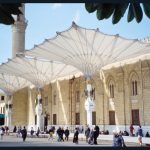
Al Hussein Mosque
The Al Hussein mosque is one of Egypt’s most beautiful sacred Islamic structures, dedicated to Al-Hussein, the Prophet Mohammed’s grandson. It is well-known for having the earliest complete manuscript of the Holy Quran. Because Al-Hussain mosque is located in a very prominent location near Khan El-Khalili Bazaar, it attracts a large number of tourists from all over the world. It is a work of art that protects the head of Hussien, who was assassinated by the Umayyads in Iraq in 680. Despite the claims of Ali, Muhammad’s son-in-law, “The Father of Hussein,” the Umayyads were acknowledged to be Muhammad’s successors. The fight for the caliphate between those generations generated several schisms within Islam. The majority of Sunni Muslims in the world did not acknowledge the Umayyad Caliphate, and they prevented anybody from approaching Ali’s dynasty. The “Shia” Partisans of Ali refused to recognize any leader unless he was a descendent of Ali, and they finally saw Al Hussein as a martyr. The majority of Muslims in Egypt now are Sunni, and Al Hussein is revered alongside Prophet Muhammad’s granddaughter, Saiyda Zeinab, as a beloved saint. Apart from the design and scale of Al Hussein mosque, the two massive umbrellas that

The Step Pyramid of King Djoser in Saqqara
The Step Pyramid of Djoser at Saqqara is one of Egypt’s most important archaeological sites. While it may not be as striking or well-known as the Giza Pyramids, this structure predates them and is crucial to archaeologists’ knowledge of pyramid development. The Step Pyramid was constructed during Djoser’s 3rd dynasty dominance in the 27th century BC. While it is not a “real pyramid” with smooth sides like those at Giza and Dahshur, it is an essential stepping stone in their development. It is also the world’s first large-scale cut-stone structure. Six separate levels, or stages, of decreasing size, are erected on top of one another to form the structure. According to archaeologists, this is an enrichment of an earlier practice in which pharaohs were buried under a mastaba, a flat rectangular structure that resembled a big burial covering. Djoser’s architects opted to stack several of these constructions to create a more intimidating monument to the king, resulting in the 203-foot-high edifice we see today. They were taking the first steps toward building the pyramids that have made Ancient Egypt famous throughout history. Controversial Theories The Step Pyramid of King Djoser in Saqqara is considered to be one of the earliest
Things to do in Cairo






Tour to the Grand Egyptian Museum (GEM Tour)
Luxor (Thebes)
The city of the one hundred gates):, Luxor is a city located in the southern part of Egypt. It is known for its rich history and is the site of ancient Thebes, the capital of the New Kingdom of Egypt. Luxor is home to many famous landmarks, such as the Valley of the Kings, the Temple of Karnak, and the Luxor Temple. The city attracts many tourists every year who want to explore its ancient sites, learn about the history and culture of ancient Egypt, and take a Nile River cruise. Luxor is also home to several museums, including the Luxor Museum and the Mummification Museum, which offer insight into the ancient Egyptian civilization. Additionally, Luxor has modern amenities, such as hotels, restaurants, and shopping centers, as well as entertainment options like live shows and casinos.
Places to see in Luxor
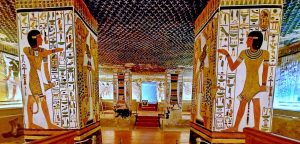
Queen Nefertari’s Tomb at the Valley of the Queens
The tomb of Queen Nefertari, which can be found in the Valley of the Queens on the west bank of Luxor, is one of Egypt’s most beautiful tombs. This tomb has a lot of “wow” aspects. The degree of detail is incredible, and the colors are more brilliant than any of Egypt’s other tombs, temples, or pyramids. Put the tomb of Queen Nefertari on your list if you want to see what tombs were like 3,000 years ago. This tomb comes at a high cost: 1400 EGP (about USD 90 as of January 2021). Is it, therefore, worthwhile? YES, we believe so. The tomb of Queen Nefertari is breathtakingly magnificent, and you will all be awestruck as you stroll inside it.The tomb remained inaccessible to the public unless a 20,000 Egyptian pound special permission was bought for a single visit.Take a look at our photo tour below to see for yourself.But first, a bit of background about Queen Nefertari and her tomb. Interesting facts about Queen Nefertari and her tomb: Ramesses II’s (also known as Ramesses the Great) first queen and most cherished wife was Queen Nefertari. She not only had one of the most beautiful graves in the Valley
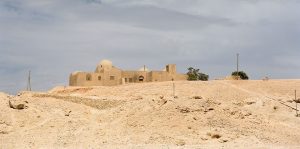
Tomb of Tutankhamun Replica & Carter’s House
Tutankhamun’s Tomb Replica & the House of Lord Howard Carter During the protracted hunt for Tutankhamun’s tomb, Carter made his home in this humble mud-brick dwelling. In the garden, you can also see an identical copy of Tutankhamun’s Tomb from the Valley of the Kings. The burial chamber of the tomb replica is an identical duplicate of the original, even down to the dust. It was designed as an experiment in modern preservation by the Factum Foundation for Digital Conservation in conjunction with Egypt’s Ministry of Antiquities. Millions of tourists visit Egypt each year to see the country’s Pharaonic tombs and temples, but their tread into the delicate environment of the tombs is severely damaging them. Come here to be amazed by how accurate the reproduction is, and think about how copies like this may be utilized to assist preserve original places in the future. You’re unable to tell the difference. Carter’s House has been renovated, with the rooms arranged up as they would have been when he lived there, and the walls are covered with intriguing black-and-white pictures chronicling his work. The location is on the main West Bank road, right before the turnoff to Seti I’s Mortuary Temple.
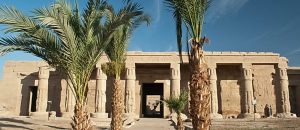
Mortuary Temple of Seti I
Seti I, the king of Abydos’ splendid temple, his exquisite tomb in the Valley of the Kings, and Karnak’s magnificent hypostyle hall, died before this memorial temple was completed, so his son Ramses II, who had a stronger hand, finished it. Despite its beautiful setting amid a palm grove, this temple at the northern end of the Theban necropolis sees few visitors. Floods in 1994 seriously destroyed the temple, which has since been completely rebuilt. A tiny door in the northeast corner of the restored fortress-like enclosing wall leads to the entryway. The first and second pylons, as well as the court, are all destroyed. The pharaoh’s palace has likewise vanished, but its foundations have recently been discovered immediately south of the court, making it the earliest surviving example of a palace within a memorial temple; its layout is comparable to the better-preserved palace at Ramses III’s Medinat Habu memorial temple. Some excellently wrought reliefs may be found on the walls of the columned portico on the temple’s west front, as well as those of the hypostyle court beyond it. Six shrines flank the hypostyle, and to the south is a tiny chapel dedicated to Seti’s father, Ramses I, who
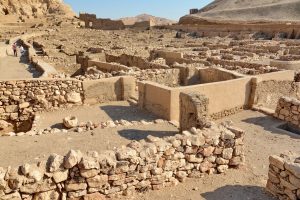
Deir El-Medina
During the 18th to 20th Dynasties of the New Kingdom of Egypt (ca. 1550–1080 BCE), Deir el-Medina, or Daiyr el-Madinah, was an ancient Egyptian workmen’s hamlet that was home to the artisans who worked on the tombs in the Valley of the Kings. Set maat “The Place of Truth” was the settlement’s original name and the workers who resided there were known as “Servants in the Place of Truth.” The temple of Hathor was transformed into a church during the Christian era, giving it the Egyptian Arabic name Deir el-Medina (“town monastery”). While the world’s attention was focused on Howard Carter’s discovery of Tutankhamun’s tomb in 1922, a team led by Bernard Bruyère began excavating the site. This research has resulted in one of the most comprehensive descriptions of communal life in the ancient world, spanning over 400 years. There is no other site that allows you to study a community’s organization, social relationships, working, and living circumstances in such depth. On the west bank of the Nile, across the river from modern-day Luxor, the site is located. The town is set in a tiny natural amphitheater, with the Valley of the Kings to the north, funerary temples to the
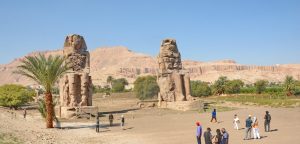
Colossi of Memnon
The Colossi of Memnon are two huge stone sculptures of Amenhotep III, the Egyptian king who ruled during the Eighteenth Dynasty. They have stood in the Theban Necropolis, west of the Nile River from the present city of Luxor, since 1350 B.C. The Colossi of Memnon are the most well-known monuments on the West Bank. These massive sculptures stand right before the main West Bank ticket office, alongside the major road that goes from the Luxor neighborhood of Al-Gezira on the west bank of the Nile. They depict Amenophis III seated on a cube-shaped throne, and originally stood watch at the entrance to the king’s temple, of which only meager remnants remain. They were taken for sculptures of Memnon, son of Eos and Tithonus, who was killed by Achilles during the Trojan War during Roman Imperial times. The Colossus of the South is in better condition than the one to the north. It rises 19.59 meters tall, with the base partially covered in sand. The entire height must have been around 21 meters with the crown that it once wore but has now disappeared. The North Colossus is the well-known “musical statue” that drew crowds throughout the Roman Imperial era.
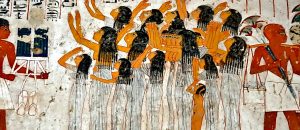
Tombs of the Nobles
There is a substantial section for the nobles’ tombs in every important ancient Egyptian necropolis, such as Giza plateau, Saqqara cemetery, Amarna graves, Luxor cemeteries, and Aswan graves. Almost everything we see now in Ancient Egypt is dedicated to the pharaonic royal family. Because of their immense scale and the fact that they are actually cut out of stone, the colossal construction projects that Egyptian kings commissioned throughout the civilization’s history have withstood the test of time far better than other ancient artifacts. In the temples and royal tombs surrounding Luxor, victorious kings’ triumphant iconography and images of endless life after death might grow monotonous. A visit to the Tombs of the Nobles (or the Worker’s Village) could be a smart option if you’re feeling overwhelmed with temples. The nobles’ tombs in Luxor still have magnificent murals that aren’t so much about leading the deceased to the afterlife as they are about depicting scenes from everyday Egyptian life. The Nobles’ Tombs stand out among the rest of the West Bank sites because they deviate from the norm. These groups of tombs cut into a rocky slope between the Ramesseum and Hatshepsut’s Temple are all devoted to administrators, governors, and other

Dendera Temple Complex
If time allows, visitors to Luxor should try to see the renowned Dendera Temple Complex. From Luxor, the trip takes around an hour by cab. In one day, travelers may see both Dendera and Abydos temples on a private trip. Dendera Temple Complex Location The Temple is located approximately 4 kilometers from the Nile’s west bank, roughly opposite the city of Qena. Both Coptic and Muslim people live in the capital of the province and governorate of Qena (population – of 2,000,000). This village produces water pots, also known as “Qula” jars in Arabic. Abdel Raheem El-Kenawi, a Muslim Sheik, lived his entire life in this village. His death in 1170 A.D. marked the beginning of the modern city, and his birthday is commemorated every year. For the festivities, a large number of pilgrims travel from all across Egypt. The name Qena comes from the ancient Egyptian word Qeny, which means “to bend”; the River Nile has a significant (and famous) curve here. History and Description: Ptolemy VIII and Queen Cleopatra II erected the Temple of Hathor in the first century B.C., and it is one of Egypt’s best-preserved temples! It was later decorated by Roman Emperors to commemorate Hathor,
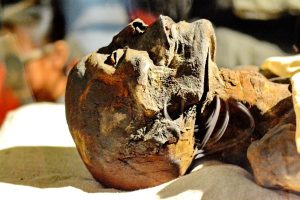
Luxor Mummification Museum
The Mummification Museum is a unique and intriguing spectacle to study in the neighborhood of the magnificent Nile River, more particularly in the endless and magical city of Luxor, the ancient Thebes. There, the art of mummification is precisely represented in ancient Egypt’s time, which is divided into three periods: the Old Kingdom, the Middle Kingdom, and the New Kingdom. You may observe mummified animals and learn about many of the equipment and materials utilized for such operations during the period. An interesting display of the ancient Egyptian technique of mummification may be seen in this modest museum on the Nile’s banks. Instruments for extracting internal organs, medications for treating the body, and things required for the mummy’s passage to the afterlife are all on exhibit. Maseharti, a high priest and commander from the 21st Dynasty, was discovered with his painted coffin at Deir el-Bahri. Among the other displays are a mummified cat, a symbol of the goddess Bastet, and a mummified ram, a symbol of the deity Khnum. A cross-section of a mummified skull, filled with material where the brain has been removed, is one of the educational artifacts on exhibit. A fragment of a mummified toe is also

Luxor Museum
Luxor is a true cradle of humanity’s cultural legacy, but it is also a city that must meet the requirements of its residents on a daily basis. The Luxor Museum of Ancient Egyptian Art had difficulty in including the local population in the program of a site museum in one of the world’s most popular international tourist sites. The author is the museum’s general manager. The Luxor Museum of Historic Egyptian Art is located in the ancient and world-famous town of Luxor, which is located roughly 670 kilometers south of Cairo, Egypt’s capital, and has a population of around 70,000 people. The museum is located on the Nile Corniche Boulevard, which runs along to the Nile River and faces the Ramesseum on the west bank, and links the Luxor and Karnak temples. The river divides the town center into two pieces as it runs through it. The first segment is on the east bank, where the bigger and main part of the town is located, and where ancient Thebes was Egypt’s metropolis for almost three centuries during the New Kingdom’s 18th and 19th dynasties (1550–1196 B.C.). The ancient Egyptians constructed mortuary temples to the gods beside the dead Kings resting
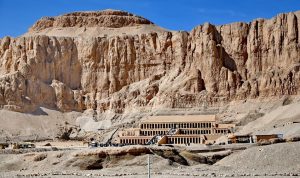
Queen Hatshepsut Temple
The queen who became a ruler, Hatshepsut (c.1473–1458 BC), constructed a beautiful temple at Deir al-Bahari, on the west bank of Luxor. It is immediately across the Nile from Karnak Temple, the deity Amun’s primary shrine. Senenmut, Amun’s top steward, created Hatshepsut’s temple, Djeser-djeseru “the Holy of Holies”. The temple is divided into three floors, each with a colonnade at the far end. Just beyond the portico on the topmost level is an open courtyard. Hatshepsut as Osiris, the deity of the dead, is shown in mummiform sculptures leaning on the pillars. This is because Djeser-djeseru is Hatshepsut’s mortuary temple, where she performed her religion after she died and achieved the fortunate condition of Osiris. The temple isn’t exclusively dedicated to her; it also has portions dedicated to her renowned father Thutmose I, the goddess Hathor, and the burial deity Anubis. The religion of the solar RaHorakhty was honored with an altar that was exposed to the sky and the sun. Amun was awarded the honor of being first. A path carved directly into the living rock culminates in his shrine at the far end of the top courtyard, on the temple’s central axis. Beautifully painted reliefs adorn the temple
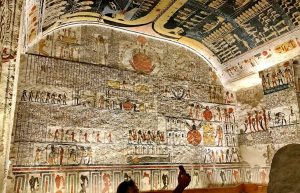
Valley of the Kings
The road where God Ra “The Sun God” sets. The Kings of Egypt’s affluent New Kingdom (1550–1069 BC) were buried in a barren dry river valley across the Nile from Luxor, thus the Valley of the Kings’ current name. This title isn’t fully true, though, because certain members of the royal family other than the King, as well as a few non-royal, but extremely high-ranking, persons, were buried here as well. The East and West Valleys make up the Valley of the Kings. The eastern valley is by far the more famous of the two, with only a few graves in the western valley. In total, there are 65 tombs in the Valley of the Kings. This royal burial ground’s location was chosen with great care. Its location on the west bank of the Nile is also noteworthy. The west acquired funeral connections since the sun god set (dead) in the western horizon before being resurrected, and regenerated, on the eastern horizon. For this reason, ancient Egyptian graves were mostly found on the Nile’s west bank. Under the shadow of a pyramid-shaped peak rising out of the rocks surrounding the valley, the New Kingdom’s strong rulers were put to rest.
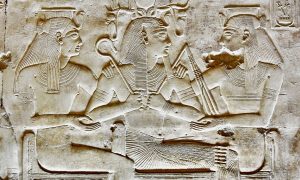
Abydos Temple – The Great Temple of King Seti I
Abydos Temple The Abydos Temple, also known as the Seti I Temple, is one of Abydos’ most important historical landmarks. Pharaoh Seti I started construction in the temple, and it was completed by his son King Ramses II. The Osireion is located in the back of the temple.The Temple is one of the most important temples in history since it includes crucial proof of ancient Egyptian beliefs and ideas about the deity Osiris, his wife goddess Isis, and their son Horus! The essence of the God Osiris myth was incorporated into the account of Jesus’ birth from a virgin mother without a physical father.The Abydos Temple is dedicated to the worship of God Osiris, a powerful god in ancient Egypt who looked for his offspring and land. Osiris was the God of All Gods of the Afterlife, and he symbolized stability.The enormous temple of Abydos retains most of the hues of its representations, as well as beautifully preserved images that transport you to another time.The significance of the Abydos Temple stems from several specific images uncovered on the temple’s walls, such as depictions depicting the miraculous birth of the savior God Horus and the Kings’ List. Abydos Temple & The
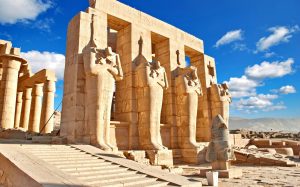
The Ramesseum Temple
In 1304-1207 B.C., Ramses II erected the Temple of the Ramesseum as a funeral temple devoted to the God Ra. The majority of the Temple is currently in a state of disrepair or destruction. Two pylons that previously stood near the Temple’s entrance have since collapsed. There is just a colonnaded hall that has survived in the Temple’s initial courtyard. A huge sculpture of Ramses once stood in front of the remains of the first pylon, weighing more than 1000 tonnes and standing 18 meters tall! The ruins of it can still be seen today. Many other kings, like Mernptah and Ramses III, have overlaid monuments at the Ramesseum. The Greeks called it the Temple of Memnonium because the huge statue in front of it was linked with Memnon, the son of Aurora, whose mother, Eos, was the goddess of dawn. They also referred to it as “Ozymandias’ tomb,” a term that may have been derived from the ancient Egyptian word “User-Maat-Ra”. Diodorus, a Roman historian, believed that the Temple was built by the legendary King Ozymandias and that his grave was situated within it. He also goes into great detail about the tomb of Ozymandias, including the inscription on
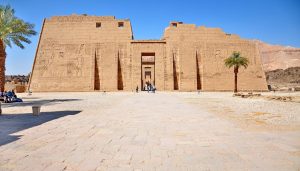
Madinet Habu Temple of King Ramses III
The Mortuary Temple of Ramesses III is located near Medinet Habu. It was a fortified location with walls that encircled Hatshepsut’s earlier Temple of Amun and the Mortuary Temple of Divine Adoratrice of Amun. A palace adjacent to the temple was likewise encircled by the walls. Ramesses III is supposed to have resided at the palace and had his funerary temple erected before his death. The Temple of Amun’s Divine Adortrices was dedicated to the numerous deceased daughters of Pharaohs who served in this religious capacity. The yearly pilgrimage of the Karnak Barque of Amun, which was brought in procession from Karnak to the Temple of Luxor and then across the Nile to this temple, took place at the Temple of Amun. Every 10 days, Amun of Luxor (Luxor Temple) went to and from the Temple of Amun at Medinet Habu, probably to coincide with the start of each “decan” as shown by the star charts. These processions were made easier by a canal and a boat landing. Ramesses III is said to have died in the upper chambers of the gate. He is said to have been assassinated in a royal plot. The temple itself has three courts, as
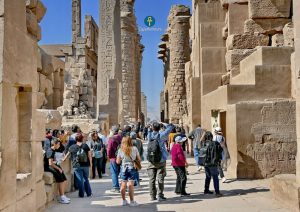
Karnak Holy Temple Complex
The Karnak Temple in Luxor is the world’s largest temple complex, with so many components and sizes that each portion of the temple was erected by a different King from the new Egyptian Kingdom. The oldest part of the temple dates from the time of King Mentohotep NebhepetRa, the founder of the middle ancient Egyptian kingdom. He was the 9th king of the dynasty to which he belonged, but he is considered the founder of a kingdom because he reunited Egypt’s two lands into one country (2061 BC – 2010 BC). Even Alexander the Great and his brother paid close attention to the Karnak temples, sharing building materials and rebuilding others. The temple was formerly connected to the Nile by the Sphinxes Avenue, which still survives in part. When talking about Karnak, it’s worth describing the contents of an ancient Egyptian temple because tourists will see numerous temples inside and this will help you distinguish each temple in the complex. The ancient Egyptian temple consists of: An open courtyard (the biggest part of the temple) the first pylon (consists of two separate parts) Colonade (a courtyard surrounded by columns) the second pylon (also consists of two parts) the hypostyle hall
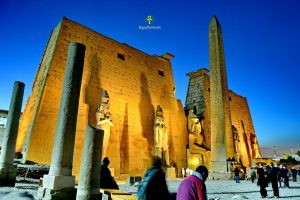
Luxor Temple
History of Luxor Temple Luxor temple is one of the most beautiful temples in ancient Egypt. The temple was started by King Amenhotep III from Dynasty 18. However, it is believed by some archeologists that the oldest part of the temple dates back to the time of King Mentohotep the founder of the Middle Kingdom. It seems that the ancient kings followed a long-term construction plan to finish the temple in centuries, not decades. The sanctuary, the hypostyle hall, and a colonnade were built by King Amenhotep III. The smart plan gave out two options, one is to leave the temple as it is by Amenhotep III, and it looked finished even with an entrance that led directly to the colonnade, and the second option was to extend and enlarge the temple starting from that entrance!! The visitor can easily see the difference in style between the parts of the temple as the columns built by Amenhotep III are all one design which is a cluster of plans representing harvest. King Tutankhamun -from the dynasty 18- added another colonnade with the style of the open flower capitals to represent irrigation season. He also added some unique statues of him represented
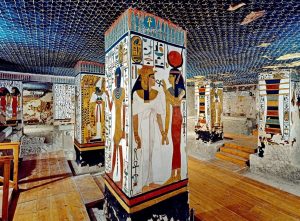
The Valley of The Queens
The Valley of the Queens, on Luxor’s west bank, has 78 tombs of Egyptian queens from the 18th, 19th, and 20th dynasties. The tomb of Queen Nefertari, King Ramses II’s wife, is the most renowned of them all. The tomb of Khaemwese (tomb 44) is among the valley’s tombs. Scenes in Khaemwese’s tomb depict him and his father being brought to the guards of the gates of the afterlife. He is clothed in a robe, wearing a necklace, and sporting the sidelocks of youth as he makes an offering in the scenario. Queen Titi’s Tomb (Tomb 52): She is most likely the 20th Dynasty’s queen. She is shown in the company of the gods Thoth, Atum, Isis, and Nephthys, with sidelocks typical of Egyptian youth of the time. The queen is seen presenting gifts to Hathor the cow in the next chamber, while the gods Neith, Osiris, Selquit, Nephthys, and Thoth are shown in the last chamber. Amenhikhopeshef’s tomb (Tomb 55): Amenhikhopeshef was a son of Ramesses III, and scenes depict him with his father and gods such as Thoth, Ptah, and others. When he died, he was probably around nine years old. His father, Ramesses III, is shown presenting

Luxor Hot Air Balloon
Luxor Hot Air Balloon: An Experience of a Lifetime. If you’re looking for an adventure that’ll give you a bird’s-eye view of Luxor’s iconic landmarks, a hot air balloon ride is a must-do. Imagine soaring high above the Valley of the Kings and Queens, watching the sunrise over the Nile River, and spotting ancient temples and tombs from the sky. Simply put, a hot air balloon ride is an experience of a lifetime. Most hot air balloon tours in Luxor start early in the morning, just before sunrise. You’ll be picked up from your hotel and driven to the launch site, where you’ll watch the balloons being inflated and prepared for flight. Once everything is ready, you’ll climb into the basket and take off into the sky. As you ascend higher and higher, you’ll be able to spot some of Luxor’s most famous sights, such as the Karnak Temple, the Hatshepsut Temple, and the Colossi of Memnon. The views from the hot air balloon are simply breathtaking, and you’ll get a unique perspective on the ancient wonders of Egypt. One of the most beautiful sights during a hot air balloon ride is the sunrise over the Nile River. The colors
Things to do in Luxor

Trip to Edfu and Kom Ombo from Luxor
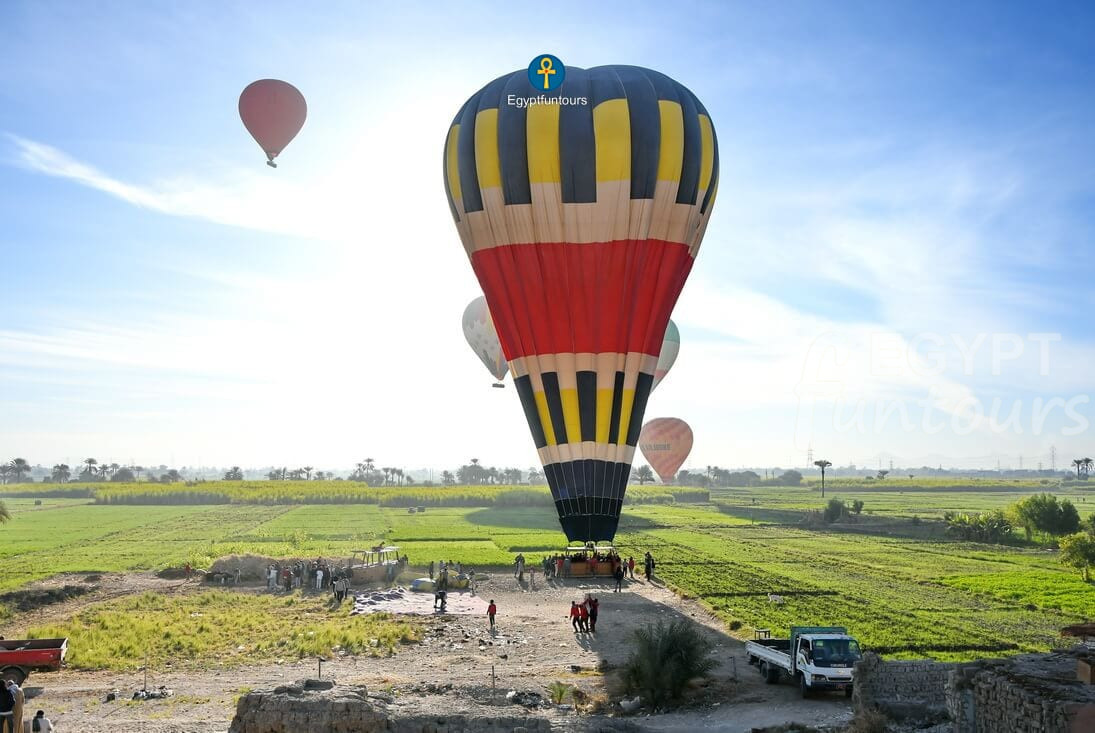

Tour To Luxor and Karnak Temples

Luxor Horse Carriage Trip

Luxor West Bank Day Tour


Trip to Dandara and Abydos from Luxor


Edfu and Kom Ombo from Luxor

Tour to Luxor West Bank from Luxor
Aswan
Aswan is a city located in southern Egypt, on the east bank of the Nile River. It is also known as Aswan City or Assuan and is the third largest city in Upper Egypt. Aswan has a long and rich history dating back to ancient times and was an important center for trade and commerce, particularly in the time of ancient Egypt. The city is famous for its archeological sites, including the Aswan Dam, the Temple of Philae, and the Unfinished Obelisk. Aswan is also known for its beautiful landscapes, including the Nile River, desert wilderness, and Nubian villages. Visitors can enjoy a variety of activities in Aswan, such as visiting historic sites, taking a Nile River cruise, exploring Nubian culture, shopping in local markets, and more. The city is a popular destination for tourists who are interested in history, culture, and natural beauty.
Places to see in Aswan
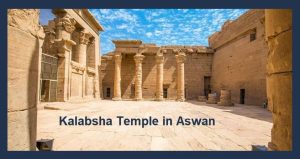
Kalabsha Temple
The majestic Kalabsha temple is a spectacular landmark located within view of Aswan’s High Dam and is the first stop on any Nile River Cruise on Nasser Lake. When you arrive, take a stroll over the temple’s lovely stone causeway, which leads to the temple’s first pylon. Then you’ll walk through a colonnaded court with eight columned hypostyle halls. Its amazing hieroglyphs and reliefs reveal a lot about the Greek Pharaohs and ancient Egyptian gods and goddesses. The temple of Kalabsha was completed during the reign of Augustus, the Roman emperor, near the close of the Ptolemaic period. The temple was primarily dedicated to Mandulis, a Nubian divinity. Kalapsha temple was transferred from its original location roughly 30 miles to the south after the building of the High Dam. The temple of Kalabsha is a one-of-a-kind fusion of ancient Egyptian and Greek motifs, myths, and religions. A massive wall connects the temple’s huge Pylon to the rest of the complex. If you take the steps up to the upper portion of the temple, you may have a great view of the lake and the towering dam from the temple’s roof. The Kalapsha temple was nearly destroyed by Lake Nasser’s overflowing
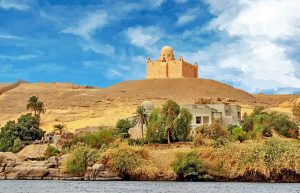
Aga Khan Mausoleum
A Testament to Architectural Excellence and Spiritual Legacy Nestled within the serene landscapes of the lush Botanical Garden in Aswan, Egypt, stands the magnificent Aga Khan Mausoleum. This elegant structure, dedicated to the memory of Sir Sultan Muhammad Shah Aga Khan III, is an architectural gem that captivates visitors from around the world. Unveiling a blend of Islamic and modern influences, the mausoleum not only pays homage to a visionary leader but also represents a spiritual sanctuary that embodies peace and tranquility. Join us on a journey to explore the profound significance and captivating beauty of the Aga Khan Mausoleum. Historical Significance: The Aga Khan Mausoleum, commissioned by Prince Karim Aga Khan IV in 1954, honors his predecessor and grandfather, Sir Sultan Muhammad Shah Aga Khan III, who held a prominent role in the Islamic community. Sir Sultan Muhammad Shah Aga Khan III was the 48th hereditary Imam (spiritual leader) of the Shia Ismaili Muslims. Throughout his life, he dedicated himself to the advancement of education, social welfare, and architectural preservation. Aga Khan Mausoleum: Architectural Marvel: Designed by Egyptian architect Mahmoud El-Hakim, the Aga Khan Mausoleum boasts a harmonious fusion of traditional Islamic and contemporary architectural elements. The structure stands
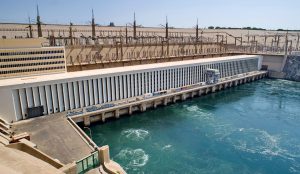
Aswan High Dam
Aswan High Dam: Harnessing the Power of the Nile The Aswan High Dam, an engineering marvel situated on the River Nile in Egypt, stands as a testament to human ingenuity and the pursuit of progress. This colossal structure, completed in 1970, has transformed the lives of millions through its ability to control the flow of the Nile and harness its immense power for agriculture, electricity generation, and flood prevention. Let us delve into the fascinating story of the Aswan High Dam, exploring its historical significance, engineering prowess, and the impact it has had on Egypt’s development. Historical Background: The idea of constructing a dam on the Nile traces back to the late 19th century when visionary leaders recognized the immense potential it held. The Nile River, known as the lifeblood of Egypt, had been a source of both life and destruction for centuries. Its annual floods brought fertile soil, essential for agriculture, but also caused devastation in the form of widespread flooding. The aspiration to harness and control the Nile’s power led to the realization of the Aswan High Dam project. Engineering Marvel: The Aswan High Dam, designed by a consortium of international engineers and architects, is an astonishing feat

The Nubian Museum
The Nubian Museum: Preserving Rich Heritage and Ancient Civilization Nestled on the eastern bank of the Nile River in Aswan, Egypt, lies the remarkable Nubian Museum. This cultural gem stands as a tribute to the indigenous Nubian people and their ancient civilization, offering visitors a glimpse into their rich heritage and vibrant culture. With its extensive collection of artifacts and interactive exhibits, the Nubian Museum serves as a gateway to understanding the significant contributions of the Nubian civilization to world history. In this article, we will delve into the captivating history of the Nubian Museum, its architectural splendor, and the importance of preserving this invaluable cultural heritage. Historical Background: The Nubian Museum was established in 1997, following the construction of the Aswan High Dam and the subsequent flooding caused by Lake Nasser, which threatened to submerge numerous Nubian archaeological sites and displace local communities. The museum was conceived as a means to salvage, preserve, and showcase the Nubian culture and history that faced the risk of being lost forever beneath the waters. Architectural Splendor: Designed by renowned Egyptian architect Mahmoud El-Hakim, the Nubian Museum’s breathtaking architecture is a testament to the fusion of traditional Nubian and modern design elements. The

Tombs of the Nobles at Aswan
Unlocking the Mysteries of Aswan’s Tombs of the Nobles Nestled within the picturesque city of Aswan in Upper Egypt lie the Tombs of the Nobles, an extraordinary collection of ancient burial sites that offer a captivating glimpse into the lives and customs of the elite during Egypt’s golden era. With their intricate carvings, vibrant colors, and rich historical significance, these tombs serve as a vital link connecting us to the royal courts and noble families of Pharaonic Egypt. In this article, we will embark on a journey through time to explore the Tombs of the Nobles, their historical context, architectural beauty, and the stories they reveal. Historical Context: Dating back over four millennia, the Tombs of the Nobles were constructed throughout the Old, Middle, and New Kingdoms of ancient Egypt. Aswan, strategically located at the southernmost point of the country, played a crucial role in the flourishing trade and cultural exchange between Nubia and Egypt. It was here, amid the serene beauty of the Nile River’s banks, that the nobles of Aswan chose to lay their loved ones to rest. Architectural Marvels: The Tombs of the Nobles demonstrate a fascinating blend of Egyptian and Nubian architectural styles, reflecting the cultural
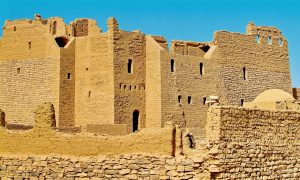
Monastery of St. Simeon
One of Aswan’s most distinctive features. On the Nile’s West Bank, the magnificently picturesque Monastery of St. Simeon lies amid the sand dunes. It is one of Egypt’s largest and finest preserved Coptic monasteries, having been founded in the 7th century and abandoned in the 13th century owing to water problems. The southern flank of the monastery is taken up by an aisled Basilica inside the monastic courtyard. The massive apse, with three rectangular niches beneath semi-domes, is located at the east end of the wide nave, which was formerly capped by two domes. The remnants of a fresco portraying Christ enthroned amid angels may be found in the center niche. Various secondary buildings and tiny grottoes may be seen to the north and west of the church, while residential quarters can be found on the eastern side. Upstairs, the monk cells, with brick beds and Coptic and Arabic writings on the walls, are among the better-preserved barrel-vaulted living spaces. Standing atop the defensive walls of the monastery and looking out over the undulating dunes gives you a sense of the monks’ solitude. You may hire a boat or felucca to transport you to the monastery boat landing today, and
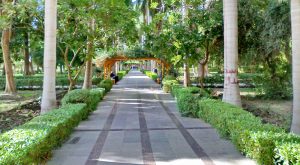
Aswan Botanical Garden – Kitchener’s Island
The Aswan Botanical Garden, which spans 6.8 hectares, is home to hundreds of birds and exotic plants imported from all over the world, including the Far East, India, and Africa. The Aswan Botanical Garden is a lovely and one-of-a-kind retreat from the metropolis. A veritable treasure trove of Egyptian antiquities, wandering around the garden will transport you to a dreamlike state of beauty. The entire island is manicured with rare and exotic flora planted by Lord Horatio Kitchener, who gave the island in appreciation for his service as consul general of Egypt Army under British authority. Kitchener’s Island (Aswan Botanical Garden) is located west of Elephantine Island. It is one of two Nile islands right next to Aswan, Egypt’s city center. Kitchener’s Island History: While settling in Aswan, the Nubians made advantage of the Aswan Botanical Garden, which they called Jet Nart When Lord Horatio Kitchener acquired the island in 1899, it became the “Lord’s House” for his campaign. In the Egyptian Army, Lord Kitchener served as a commander. Dedicated to palm palms and plants, Kitchener converted the entire island of Kitchener’s Island into a magnificent botanical paradise. When Egypt regained the island, it was renamed the Aswan Botanical Gardens,

Elephantine Island
Elephantine Island, Aswan’s main tourist attraction, is peppered with palm tree plantations and sloping settlements of colorful mud-brick homes. The Aswan Museum and the Ruins of Abu, Aswan’s most ancient town, are located at its southern end and include the Old Kingdom Temple of Khnum and the Temple of Satet. The museum, housed in a magnificent late-nineteenth-century villa, is partially open and houses a collection of items spanning Elephantine Island’s history up to the Roman era.Aswan’s Nilometer is located on the eastern embankment near the ruins and down a flight of stairs. With these stone-hewn wells, the ancient Egyptians measured the Nile’s rise and fall, allowing them to estimate the height of the yearly flood and so anticipate the success of their crop. After you’ve done exploring the ruins, go north onto the island to explore the backstreets of the towns of Koti and Siou, where the dwellings are brightly colored. In the small passageways, sheep graze and birds peck, while farmers cultivate their gardens as they have for decades. You may take a rowboat to Kitchener’s Island from the boat landing on the western side of the island at Siou. This island was formerly the property of Lord Kitchener,
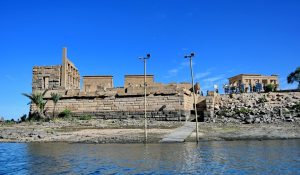
Philae Temple Complex
Egypt’s ancient center for the cult of Isis, the Temples of Philae were venerated from the Pharaonic era through the Greek, Roman, and Byzantine periods with each ruler making their own additions to the stones here. This sacred site has dazzled travelers since the first Nile cruises set off from Cairo, and is one of Nubia’s most important monument sites. The temples were saved from a watery grave by UNESCO’s rescue operation when the Aswan High Dam was being built and was moved block by block from their original location on Philae Island to Agilika Island, 12 kilometers south of Aswan. As a result, visitors may still stroll among the columns of this historically revered monument today. This is one of Aswan’s most prominent tourist attractions. Use our visitor’s guide to the Philae Temple Complex to help you navigate the site. First Pylon: The Temple Entranceway: The Temple Entranceway goes into the main temple area via the First Pylon. It has a majestic 18-meter-high entrance with reliefs by Nectanebo thanks to its two towers and central entryway. The Birth House is reached by a doorway in the western tower with reliefs by Philometor. Two granite obelisks and two granite lions

Abu Simbel Temples
Abu Simbel is a village in the Egyptian part of Nubia, about 240 kilometers southwest of Aswan and near the border with Sudan. As of 2020, it has about 3100 inhabitants. It is best known as the site of the Abu Simbel temples, which were built by King Ramses II. The Abu Simbel temples are two massive rock temples at Abu Simbel, they are situated on the western bank of Lake Nasser, about 230 km (140 mi) southwest of Aswan (about 300 km (190 mi) by road). The complex is part of the UNESCO World Heritage Site known as the “Nubian Monuments”, which runs from Abu Simbel downriver to Philae (near Aswan). The twin temples were originally carved out of the mountainside in the 13th century BC, during the 19th dynasty reign of King Ramesses II. They serve as a lasting monument to the king and his queen Nefertari and commemorate his victory at the Battle of Kadesh. Their huge external rock relief figures have become iconic. The complex was relocated in its entirety in 1968 under the supervision of a Polish archaeologist, Kazimierz Michałowski, on an artificial hill made from a domed structure, high above the Aswan High Dam reservoir. The relocation of the temples
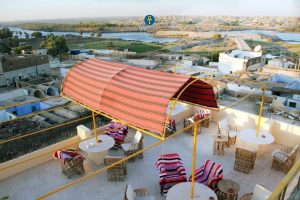
The Nubian Coffee House
The Nubian Coffee House is a café located in Aswan, Egypt that is highly regarded by both locals and tourists. The café offers a unique blend of traditional Nubian and modern Egyptian styles, creating a comfortable and inviting atmosphere. The café is located in a beautiful building which served as a traditional Nubian house, and the furniture and decor reflect the café’s blend of traditional and modern styles. The Nubian Coffee House is a wonderful place to relax, hang out with friends or family, or get some work done. The café serves a wide range of fresh coffee, tea, and other drinks, as well as traditional Nubian and Egyptian snacks and meals. The menu includes items like traditional Nubian bread, foul (a popular Egyptian breakfast dish), and shakshouka (a North African dish made with eggs, tomatoes, and spices). One of the unique features of the Nubian Coffee House is its commitment to promoting and preserving Nubian culture. The café frequently hosts live music and dance performances featuring Nubian artists, and the walls are decorated with brightly colored paintings depicting traditional Nubian life. The café is also a great spot for tourists looking to learn more about Nubian culture. The staff
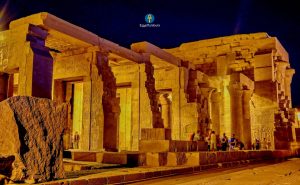
Kom Ombo Temple
Kom Ombo Is situated on the banks of the Nile some 23 miles north of Aswan and is unusual in that it is dedicated to two gods, Horus & Sobek. Sobek was the crocodile god of Nile fertility, and the bend of the river here was once home to a large number of Nile crocodiles, which were held to be sacred. Indeed, there is a small collection of mummified crocodiles in the small chapel of Hathor within the temple. The live crocodiles have long since gone, thankfully! The temple has two of everything, to accommodate the two gods, and among the reliefs on the walls – mainly from the late period and the roman time – are detailed a set of medical instruments. Scenes to see depicted on the walls of Kom Ombo temple The offering presentation on the front wall at the side of the crocodile Sobek ( king Ptolomy is standing while holding offerings in front of the holy triad Sobek, his wife, and their son, behind the king stands the high priest followed by female figures from the royal palace with 50 Hieroglyphic lines of inscriptions. The purification of the king by Horus the Falcon God, and

The Unfinished Obelisk
The unfinished obelisk in Aswan is a must-see attraction, it is located just in the heart of one of the old reddish granite quarries that the ancient Egyptian used to cut stone and make obelisks from. The site itself is a breathtaking spot because of the ancient marks of cutting stones and the chance it gives to your imagination to relive the past and see the process of making an obelisk. It is an obelisk in the middle of the site that was left unfinished by the pharaohs due to cracks that occurred during the cutting process that forced them to leave it uncompleted. There are no Cartouches on the body of the left obelisk or even any ancient hieroglyphics indicating to whom it belongs, scholars say it dates back to the time of Queen Hatshepsut just because of the history of the queen building the largest obelisk at the Karnak temples in Luxor. An obelisk is made of one single piece of granite stone, cut directly from its bedrock, and taken straight to a temple. The process of cutting an obelisk is just as so hard as transferring it. At first, an outline is precisely drawn at a width

Edfu Temple
Edfu is a small-sized city located on the west bank of the Nile River between Esna and Aswan, with a population of approximately sixty thousand people. Edfu is the site of the Ptolemaic Temple of Horus and an ancient settlement, the town is known for the major Ptolemaic temple, built between 237 BCE and 57 BCE, into the reign of Cleopatra VII. Of all the temple remains in Egypt, the Temple of Horus at Edfu is the most completely preserved. Built from sandstone blocks, the huge Ptolemaic temple was constructed over the site of a smaller New Kingdom temple, oriented east to west, facing towards the river. The later structure faces north to south and leaves the ruined remains of the older temple pylon to be seen on the east side of the first court. The temple was started by Ptolemy III, and then all this dynasty kings shared the temple, Horus temple is the second largest ancient temple in Egypt after Karnak temple. The ancient Egyptians celebrated 5 different festivals in Edfu temple, the most important among them was celebrating the divine birth of god Horus, and his holy wedding with the goddess Hathor the cow goddess. Its design
Things to do in Aswan

Abu Simbel Day Trip From Aswan By Flight

Aswan Felucca Trip

Nubian Village Tour From Aswan

Philae Sound and Light Show Tour


Edfu and Kom Ombo from Aswan

Aswan Horse Carriage Trip

Aswan Sightseeing Tour
Alexandria
Alexandria is a major city located in northern Egypt, on the coast of the Mediterranean Sea. It was founded by Alexander the Great in 332 BCE and became the capital of Egypt until its surrender to Arab forces in 642 CE. Alexandria is known for its rich history and cultural significance, as a center of Hellenic scholarship and science in ancient times. Today, Alexandria is one of Egypt’s largest cities and a major seaport and industrial center. It offers a range of attractions for visitors, including historic sites such as the Citadel of Qaitbay and the Bibliotheca Alexandrina, as well as beautiful beaches and modern amenities. Alexandria is also home to many museums, including the Alexandria National Museum and the Alexandria Archaeology Museum. Visitors can explore the city’s rich culture, enjoy local cuisine, shop in local markets, and experience the unique blend of ancient and modern that Alexandria has to offer.
Places to see in Alexandria
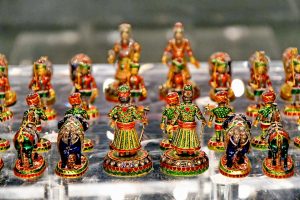
The Royal Jewelry Museum
The Royal Jewelry Museum is a two-story home that belonged to Princess Fatma Al-Zahraa, an Egyptian Royal family member, and was decorated to her liking in 1920. With burgundy plush, deep carpets, and carved, gilded ceilings, an entryway is a magnificent event. A small flight of marble steps leads to the first level from here. The walls are adorned with portraits of all the royal descendants of the Mohamed Ali Dynasty (along with a brief description). Except for her obviously outstanding sense of home decorating, little is known about Princess Fatma’s life and background. The rooms on both floors are crammed with exhibit boxes showing every conceivable object of prestige, elegance, and wealth. The royal crowns and tiaras are the most essential pieces in the collection. The platinum tiara and matching earrings stand out from the rest of the ensemble. The tiara belonged to King Fouad’s wife and was studded with 2,159 first-grade diamonds and valuable white pearls. King Farouq’s personal toilet set is also not to be missed. Huge crystal bottles with hefty gold lids and the royal coat of arms delicately perched on a gold tray make up the set. The interior decorating, rather than being dazzled by
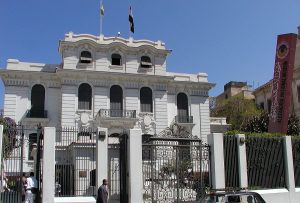
Alexandria National Museum
The National Museum of Alexandria, originally a palace, functioned as a gathering place for Alexandria’s royalty and merchant class hierarchy. The museum is divided into three levels: the basement houses Pharaonic artifacts, the ground floor houses Graeco-Roman treasures, and the first floor houses relics from Egypt’s Coptic Christian and Islamic heritage, as well as some insight into the valuables left behind by King Farouk’s family prior to the 1952 revolution. History of the Museum The structure is an Italian-style palace erected in 1928; and It is clearly recognized as being built in 1928 by Assad Basili Pasha, a wealthy businessman. There are currently 1800 items in the collection. All of the precious items are narrators of Alexandria’s rich history, opening chapters relating to the Pharaonic, Roman, Coptic, and Islamic periods. The Alexandria National Museum has four large levels with a total size of 3,480 square meters. It is designed in the manner of an Italian mansion. A lovely landscape with shaded trees and floral plants surrounds the museum. Its newly painted white exterior, with semi-circular double stairs leading to an attractive entryway, is easily visible from the street. The Alexandria National Museum is no different. A subterranean hall has been
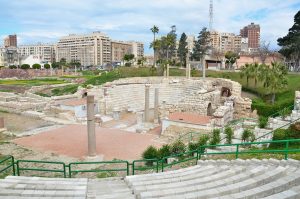
Roman Amphitheater at Kom el-Dikka
The Roman Amphitheater One of the top attractions of Alexandria is the Roman Amphitheater at Kom el-Dikka. Nobody gave much consideration to the old debris pile in central Alexandria until it was decided to remove the land in the 1960s to make room for new homes. As construction began, the Kom el-Dikka (“Mound of Rubbles”) region uncovered a slew of ancient ruins buried underground, including a tiny Roman theater. Today, the site is a tiny archaeological park with relics from Alexandria’s Greco-Roman era. There are also ruins of a Ptolemaic temple, Roman baths, and several Roman-era villas, in addition to the theater. Excavation work on the Villa of the Birds here uncovered well-preserved 3rd-century mosaic floors that have been conserved. The Roman Amphitheater at Kom el-Dikka or Roman Theatre is bounded on the north by Horrya Street, on the west by Nabi Daniel Street, on the south by Abdel Moneim Street, and on the east by Saphia Zaghloul Street. It is one of Alexandria’s emblems. Amphitheaters, which were vast and majestic in structure, were named after the Greek word for “double theatre.” Amphitheaters were open-air theaters with no curtains on the stage that were usually built in semi-circular shapes.The Roman
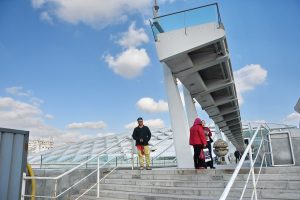
Bibliotheca Alexandrina
The Bibliotheca Alexandrina is a major library and cultural center located on the coast of the Mediterranean Sea in Alexandria, Egypt. The library is a revival of the ancient Library of Alexandria and is commemorated to honor its past splendor. The idea of reviving the old library dates back to 1974 when Alexandria University instituted a committee to select a plot of land for its new library near the campus and seafront. Construction of the library began in 1995 and has since then been inaugurated in 2002, following an expenditure of approximately US$220 million. Today, it is one of the most extensive and renowned libraries in the world. The Bibliotheca Alexandrina houses a vast collection of books with shelf space for eight million volumes. The main reading room spans 20,000 square meters and has eleven cascading levels. It also has a conference center, four museums, four galleries for temporary exhibitions, fifteen permanent exhibitions, a planetarium, and a manuscript restoration laboratory. Additionally, the library has six specialized libraries for the arts, multimedia, young people, children, rare books and special collections, and microforms. The Taha Hussein Library for the visually impaired is a unique feature of the Bibliotheca Alexandrina. It provides special

El-Mursi Abul-Abbas Mosque
The El-Mursi Abul-Abbas Mosque in Alexandria is a well-known mosque devoted to the Alexandrine Sufi saint el-Mursi Abul Abbas. El-Morsy Abul-Abbas Mosque was erected in 1775 by Algerian Sheikh Abu-El-Hassan El-Maghraby over the tomb of Ahmed Abu al-Abbas al-Mursi (Abu’l ‘Abbas), a 13th-century Andalusian scholar who joined and subsequently led the Shadhali brotherhood as a devout Sufi. He was born in the year 1219 in Murcia, Spain. He arrived in Alexandria to teach Islamic theology at the El Attarin Mosque. In 1287, he died and was buried where the mosque currently stands. The mosque was renovated several times, the most recent by the Egyptian government in 1929, and the building of the mosque was finished at the beginning of 1943. The current mosque was designed in the Andalusian style and features a distinctive octagonal layout with 22-meter sides. The mosque occupies a total area of 3000 square meters. The mosque’s walls are 23 meters high and made of artificial stone, while the minaret on the southern side stands at 73 meters. Internally, the mosque is shaped like an octagon, with sides of 22 meters. Although there is a mosaic dada 5.60 meters high, the inside walls are also covered with
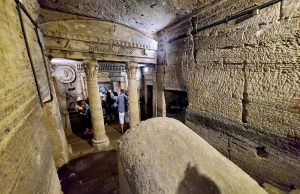
The Catacombs of Kom Esh-Shokafa
Between the ancient settlements of Karmuz and Minia el-Bassal is the rocky plateau of Kom Esh-Shogafa. The town and fishing port of Rhakotis, Alexandria’s oldest neighborhood that predates Alexander the Great, was located here. This is currently one of Alexandria’s most heavily inhabited areas, and it is here that the first catacombs were found. The region was utilized to protect the city by Mohammad Ali Pasha, and it was demolished in 1850. Kom Esh-ShoKafa excavations began in 1892, but no catacombs were discovered until Friday, September 28th, 1900. The tale goes that a donkey hauling a cart fell through a hole in the earth and into one of the tombs by mistake. Tourists are still told the story! The truth, however, is completely different! Monsieur Es-Sayed Aly Gibarah, Alexandrian mining for stone, found the genuine find. Kom el-Shuqafa, he discovered, dating from the second century AD. The catacombs are the biggest known Roman burial place in Egypt since they were designed to accommodate over 300 dead notables. After extracting the subsoil water from the 2nd level, Kom Esh-Shokafa was only accessible to the public in 1995. On three floors, the catacombs were carved out of solid rock. Ropes were used

The Qaitbay’s Fort
The Qaitbay Fort in Alexandria is considered one of the most important defensive strongholds, not only in Egypt but also along the Mediterranean seacoast. It formulated an important part of the fortification system of Alex in the 15th century A.D. About 1480 A.D, The Mameluk Sultan Al-Ashraf Qaitbay fortified the place as part of his coastal defensive edifices against the Turks, who were threatening Egypt at that time. He built the castle and placed a mosque inside it. The citadel continued to function during most of the Mameluke period, the Ottoman period, and the modern period. But after the British bombardment of Alex city in 1883, it was kept out of the spotlight. It became neglected until the 20th century when it was restored several times by the Egyptian Supreme Council of Antiquities. The fort was built on Faros Island which once accommodated the ancient lighthouse. The lighthouse was one of the seven wonders of the ancient world consisted of 4 stories. The remains of the stones of the lighthouse were used to build part of the fort.
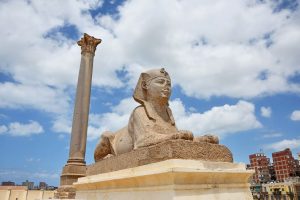
Pompey’s Pillar
The pillar is considered the largest ancient monument in Alexandria. It is rising from the ruins of the ancient and famous secretion(temple of Serapis). This column of red Aswan granite with a Corinthian capital, standing on a badly ruined substructure and rising to a height of almost 28m. It was set up in 292 A.D in honor of emperor Diocletian, who supplied food for the starving population after the siege of the city. Written on the base of this column a Greek text says: Posthumous, governor of Alex, erected this column as gratitude for the very fair emperor Diocletian.The crusades called this column wrongly Pompey’s Pillar.
Things to do in Alexandria

Alexandria Tour from Cairo


Alexandria Tour from Alexandria port
El Fayoum Oasis
El Fayoum Oasis, also known as Faiyum Oasis, is a lush green area situated in the western desert of Egypt, about 130 kilometers southwest of Cairo. It is one of the largest oases in Egypt and covers an area of about 1,270 square miles. The oasis is fed by the Bahr Yusuf Canal, which brings water from the Nile River and distributes it to the agricultural land in the area. El Fayoum Oasis is known for its natural beauty and unique landscape, with a magical lake, cascading waterfalls, and a valley of ancient whales. Visitors can enjoy a variety of outdoor activities in the area, such as bird watching, hiking, and camping. The oasis is also rich in history and culture and contains many archeological sites from various ancient civilizations, such as the Pyramid of Hawara and the Labyrinth of Egypt. Overall, El Fayoum Oasis is a beautiful and fascinating destination for anyone interested in ancient history, culture, and natural landscapes.
Places to see in El Fayoum
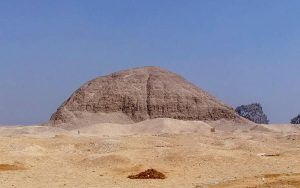
Pyramid of Hawara
About The Pyramid of Hawara The Pyramid of Hawara is located about 9 kilometers east of the oasis of Faiyoum, it was built for Amenemhet III of the 12th Dynasty in ancient Egypt. Amenemhet III was the sixth Pharaoh of the Old Kingdom’s 12th dynasty, reigning circa 1850 B.C. The Hawara Pyramid was constructed of brick stones that were subsequently covered in limestone. It is also known as the Black Pyramid. The Pyramid of Hawara was a massive building that was 58 meters high and 100 meters long on each side of the pyramid’s base when it was still intact. The Village Of Hawara The town of Hawara is located 9 kilometers southeast of El Fayoum, one of Egypt’s most beautiful places. The settlement is around 100 kilometers southeast of Cairo and has been known since ancient times under the name Hat Wa’art, which means “the footprints.” It was later Laprincess, and some historians think that this name was taken from the name of Amenmehat III’s Temple in Hawara, the “Laprent,” or “the temple placed at the lake’s outlet.” Archeologists discovered some of the most beautiful portraits in Hawara, which are now known as “the Portraits of the Fayoum.” These
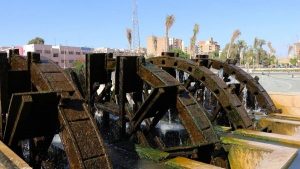
Waterwheels in Fayoum
The waterwheels in Fayoum are among the most intriguing ancient structures in Fayoum, with over 200 of them straddling the canals. The wooden wheels, which are unique to the area, are powered by the fast-moving water of the canals and were introduced into Fayoum during the Ptolemaic period. They are 4 to 5 meters in diameter and coated with black tar to protect the wood. Each waterwheel can lift the water 3 meters, spilling it onto higher ground. January is the month set aside throughout Egypt for cleaning the canals. The sluices are closed in the Fayoum, and all the working waterwheels are cleaned and repaired. In addition to the four moaning and groaning in the city center, the Famous Seven, a Fayoum trademark, are located in the countryside along Bahr Sinnuris, and there are more waterwheels on numerous canals in the area. The biggest waterwheel in Egypt may be found at Basiouniya hamlet, 14 kilometers east of Fayoum. It is 8 meters tall and weighs over 2 tonnes. This waterwheel costs 50000 EGP and provides fresh water to 88 acres (37 Hectares) of agricultural land. The waterwheel is serviced once a year during the low-flow season in mid-January, and

The Petrified Forest in Fayoum
The Petrified Forest It is a fascinating natural wonder that has captured the attention of many tourists and geologists. Situated in the Eastern Desert of Egypt near the city of Cairo, the Petrified Forest is a protected area that features the petrified remains of trees and other plant life. These trees are estimated to be about 30 million years old and provide an incredible glimpse into the past. The process of petrification occurs when the wood is buried in sediment over millions of years and undergoes mineralization. The organic matter of the tree is replaced by minerals such as silica and quartz, creating a stone cast of the original plant. The result is a unique and beautiful fossilized wood that is sought after by collectors and researchers. The Petrified Forest in Egypt is a popular tourist attraction and has been preserved as a protectorate to prevent further damage and destruction. Visitors can walk through the site and see the remains of trees that are estimated to be over 30 meters long and 1 meter in diameter. There are also several exhibits that showcase the process of petrification and the geological history of the area. The Petrified Forest in Egypt is

Qatrani Mountain
Qatrani Mountain is a fascinating geological site located in Egypt, known for its rich and diverse fossil record. The mountain is part of the Fayum Depression, a basin in the Western Desert of Egypt that formed during the late Oligocene to early Miocene period, approximately 33 to 23 million years ago. Qatrani Mountain is considered one of the most significant fossil sites in the world due to its unique and diverse collection of fossils. It contains a remarkable assemblage of mammal and plant fossils that provide important insights into the evolution of life during the Paleogene period. The fossils found at Qatrani Mountain include ancient whales, primates, crocodiles, and rodents, as well as many kinds of plants. The diverse collection of fossils found at Qatrani Mountain has enabled scientists to reconstruct an entire Paleogene ecosystem, providing valuable information about the environment and climate during this period. The fossil record also sheds light on the origins and evolution of modern-day species and helps scientists understand how life on Earth has changed over time. The first scientific investigations of Qatrani Mountain began in the early 20th century, and since then, numerous researchers have studied the site’s fossils. Thanks to their efforts, Qatrani
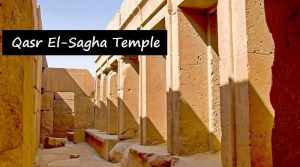
Qasr El Sagha
The Qasr El Sagha Temple is located north of Lake Qarun, 101 kilometers from Cairo. The name Qasr El Sagha translates as “Goldsmiths’ Palace.” The temple was lost years ago and was found by the archaeologist Schweinfurth in 1884, hiding in the desert to the north of Lake Qaroun and blending into the hills behind it. The rectangular temple is made of massive stones of local sandstone that are uneven in size and fit together obliquely. The southern entrance, crowned by a huge lintel, leads into a spacious hallway that leads to seven roofed shrines in the northern wall. A little hallway off the central passage to the east leads to a chamber the width of the temple, while two small connected chambers lie on the western side. On the east side, there is a short tunnel in the southern wall that is accessed through the façade. Caton – Thompson, an archaeologist, discovered a primarily middle kingdom graveyard and a small settlement of stone tools, indicating that the temple was established during the middle kingdom. The Quay A huge amount of rock may be found around 700 meters/0.4 mile to the southeast of Qasr el Sagha. Gertrude Caton-Thompson suspected that
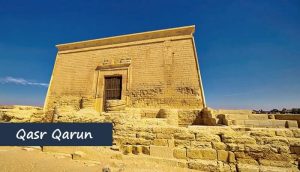
Qasr Qarun
The Qasr Qarun Temple dates from the Greco-Roman period and is located on the southwestern edge of Lake Qarun. It is 65 kilometers from El Fayoum and 120 kilometers from Cairo. The occurrence of the sun illuminating the temple on the morning of December 21st each year is a unique astronomical and architectural event when the sun also lights the Holy of Holies inside the temple, corresponding with the start of the winter solstice. The History of Qasr Qarun (The palace of Qarun is a misnomer) is a Ptolemaic temple (323-30 BC) that has not been exactly dated due to the lack of inscriptions. Built of yellow limestone blocks, it is mostly entire, however, the Antiquities Department has partially repaired the façade and strengthened portions of the internal structure. It seems little from the exterior, but within it is a true maze of chambers, hallways, cellars, tunnels, stairways, upper rooms of various sizes at various levels, and countless nooks and crannies, making it an intriguing location to explore. There are no inscriptions, but the winged sun hovers above the entrance, and on the ceiling (reachable by either of two square spiral staircases) is a relief of two figures: the crocodile
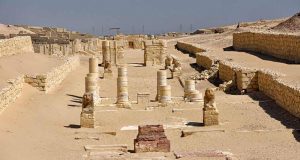
Medinat Madi
Medinat Madi literally translates as “the city of the past.” A record discovered in the 9th century A.D. identifies the word “Madi” as the name of the place. The location is home to the ruins of a temple that dates back to the Middle Kingdom. It is highly remarkable since it is hard to discover a temple from this time period. King Amenemhat III and IV erected the temple. The temple honors the holy family of the deity Sobek, the goddess Renenutet, and their son, Horus Shedet. Buildings that may still be identified today date from the late Roman and early Islamic eras (down to the ninth century). Ptolemaic dwellings may be discovered in the temple’s vicinity. Mud bricks, as well as inexpensive quarry stones, were employed as construction materials throughout history. Horizontal wooden inserts (typically palm wood) were used as reinforcement on many walls. The Divine City of Medinat Madi So yet, no public structures have been discovered in Madinat Madi. However, a significant number of churches have been found, and some of these have been cleansed. In most situations, they are simple structures. However, they are worth mentioning since comparable chapels were most likely found in a variety

Tunis Village in Fayoum
Tunis Village’s Backstory The Tunis Village was founded in the 1960s by two famous Egyptian poets who encouraged locals to become artists, but it is now better known for the arrival in the 1980s of Evelyne Porret, a Swiss woman and potter who opened her own pottery studio with her husband and quickly transformed it into a pottery school to teach all the local children how to make pottery items and encourage them to become budding potters. It still exists today, with all of the village’s youngsters working as potters and earning money for their families. What to expect in Tunis Village With many foreign nationals buying properties in the Tunis Community, the inhabitants are more than warm and welcoming, and foreigners are a daily presence in the village. It’s a terrific opportunity to observe the young artists at work and purchase examples of their work, as well as visit the town and try your hand at pottery production! There are various pottery shops that point out some of the spectacular and often rare plants, abundant trees, and shrubs, such as the ‘Bottle Brush tree,” “Spidy Silk Cotton Tree,” rose bushes, pomegranate shrubs, olive, orange, and lemon trees, and many
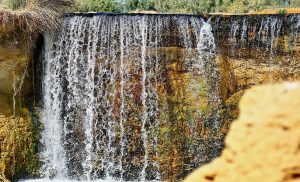
Wadi El Rayan National Park
Wadi El Rayan National Park is one of Egypt’s most famous natural reserves, located less than two hours from Cairo. The natural reserve, which is part of the El Fayoum governorate and about 75 kilometers from El Fayoum city, is named after King El Rayan Ibn El Walid, who lived in the region with his troops. Wadi El Rayan Components The upper and lower lakes, El Rayan Springs, El Rayan Falls, El Modawara Mountain (or Jabal El Modawara in Arabic), El Rayan Mountain (Jabal El Rayan), and Wadi El Hitan make up the Wadi El Rayan reserve (The Valley of the Whales). All of these regions have breathtaking scenery, including oases, mountains, rock formations, and waterfalls. White gazelles, Egyptian gazelles, sand foxes, and fennec foxes, as well as uncommon resident and migrating bird species, and several types of eagles and falcons, may all be found in the region.Archaeologists and geologists are drawn to the area because of the abundance of marine fossils and ancient artifacts found there. The Valley of the Whales, also known as Wadi El Hitan, is named for the prehistoric whale fossils unearthed in the region, which are thought to be the oldest whale fossils ever discovered

Qarun Lake National Park
Lake Qarun, some 80 kilometers southwest of Cairo in the Egyptian Fayoum region in the Nile Valley, is one of Egypt’s most prized natural monuments and a resource that has aided human civilization for over 8,000 years. It is Middle Egypt’s sole natural modern lake of any size. As a result, it is abundant in both natural and archaeological treasures. Lake Qarun has a long and illustrious history Lake Qarun is Egypt’s third-biggest and most renowned lake, after Lake Nasser in the southern portion of the country. It is located 45 meters below sea level in the Fayoum depression’s lowest, northern part. People in Fayoum say that if you haven’t seen the lake, you haven’t seen Fayoum. It is simply known as the Berka within the Fayoum, which means “little lake” in Arabic. The lake offers some of the most magnificent scenery, and taking a small boat out on the water is a fantastic experience. Lake Qarun, in actuality, is a large saline body of water that is unsafe for drinking. While the southern and eastern coastlines are inhabited, with irrigation systems providing freshwater, the northern shore is barren desert, unregulated, and difficult to access. The lake has a complex
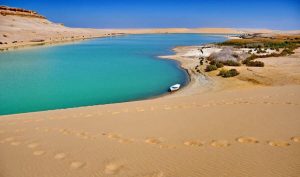
The Magic Lake in Fayoum
The Wadi El Rayan protectorate has a magical lake in the Fayoum governorate. It is a little natural lake flanked on two sides by a large mountain and on the other by vast sand dunes. It is known as the magical lake because it changes color multiple times during the day depending on the time of day and the amount of sunshine. Swimming and camping are both possible at the lake. It also provides an excellent opportunity to take amazing photographs while relaxing by the lake and taking in the landscape. Things to do by the Magic Lake The lake is a popular destination for tourists and locals alike, who come to enjoy its peaceful ambiance and scenic views. Visitors can swim, fish, or simply relax on the shores of the lake, taking in the beauty of the surrounding landscape. It is also a popular camping site, where visitors can spend the night in tents and enjoy the tranquility of the lake under the starry sky. The water of Magic Lake is salty but still supports a diverse ecosystem of plant and animal species. The lake is home to several species of fish, including tilapia, which are popular among local
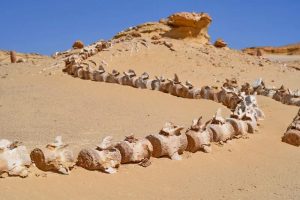
Wadi El Hitan National Protectorate in Egypt
Discover the amazing wonders of Egypt’s heritage at Wadi El Hitan National Protectorate. Do you think visiting 6000-year-old tombs and temples is like peeking into the past? Try Wadi El Hitan National Protectorate and watch whales that are 40 million years old! The Valley of Whales, 150 miles southwest of Cairo, is a UNESCO World Heritage Site that contains relics of the ancient Tethys Sea when Egypt was flooded and sea cows, crocodiles, and turtles swam. But it is most well-known for providing insight into the evolution of whales. Whale relatives roamed on land and hunted in shallow waters fifty million years ago, much like sea otters do now. For the following 10 million years, Archaeoceti (ancient whales) adopted a more marine lifestyle. The Fossil and Climate Change Museum opened in 2016 and features outstanding displays in English and Arabic that describe the area’s climatic changes over time and how land-based animals evolved to return to the sea. The fossils, on the other hand, aren’t only on exhibit. Along a walking route covered with invertebrate fossils and bone fragments, whole skeletons of Basilosaurus and Dorudon are on exhibit, some of which still have little hind limbs not found in current
Things to do in El Fayoum

Overnight Camping Trip to El-Fayoum Oasis from Cairo
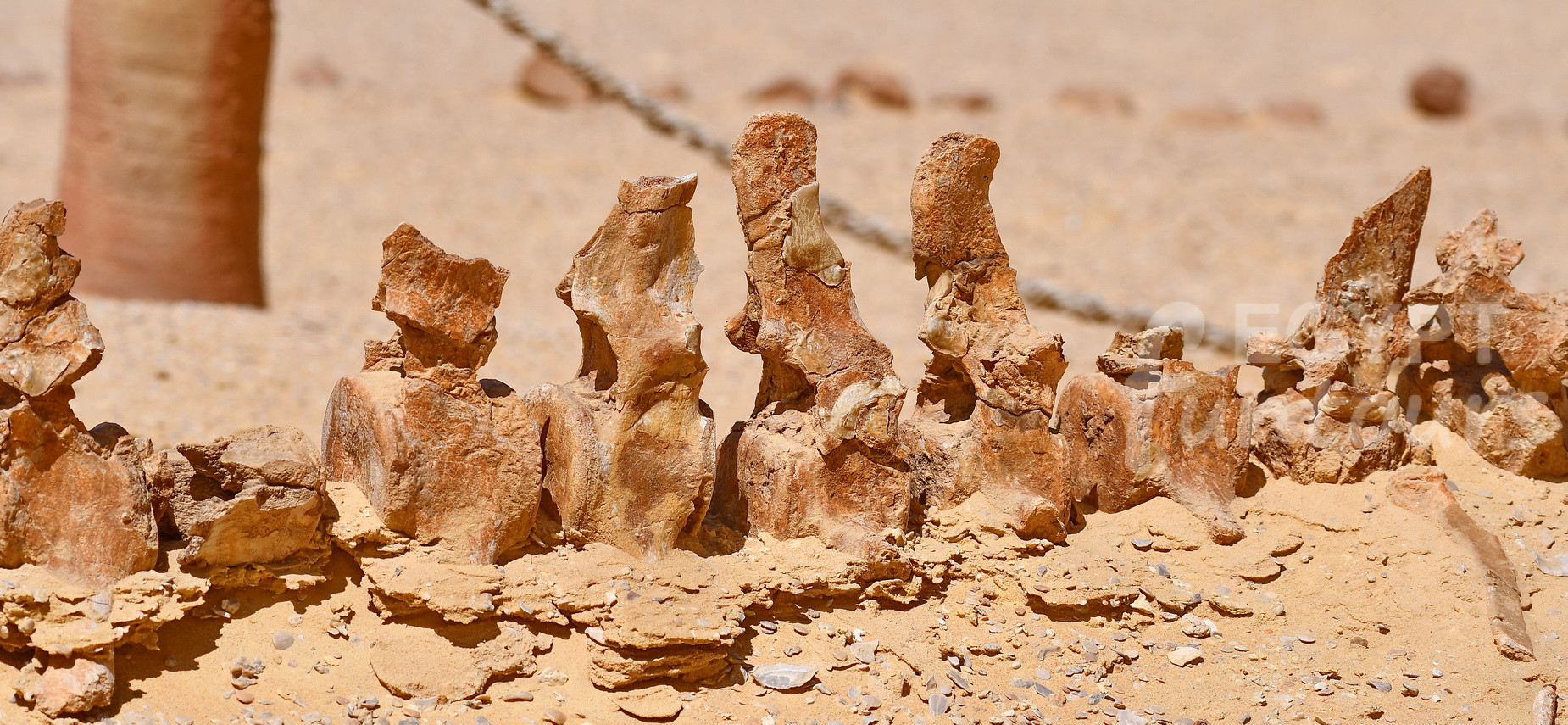
Day Trip to Wadi El Hitan from Cairo


7 Days Tours Around Cairo
